5 Tips for Understanding Nautical Flags & their Meanings
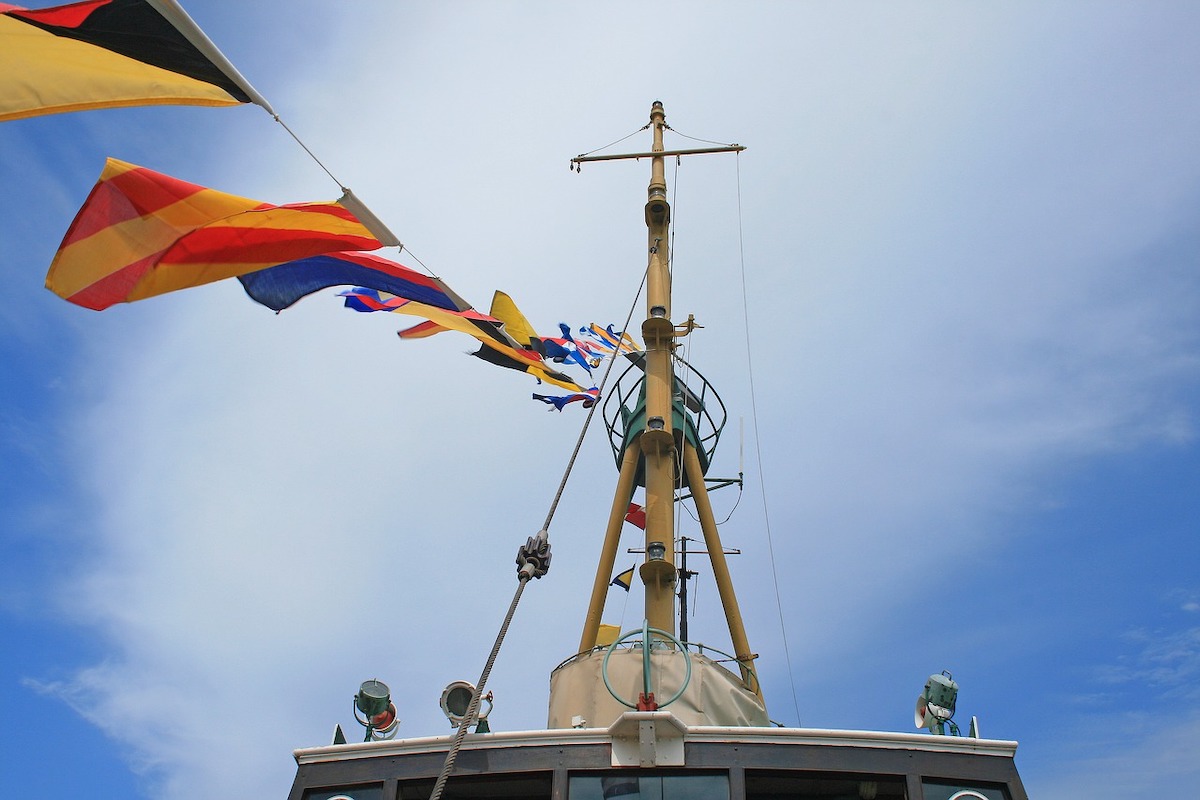
If you’re curious as to the deeper meaning behind these signals, here’s some nautical flags know-how.

1. Shapes and types are important.
Nautical flags mostly take the forms of squares, though you’ll also see pendants, which are triangular with a flat tip. You’ll additionally see what’s called substitutes (alternately called repeaters), which are triangles. Since this is a “flags 101” article, we’ll focus on the squares and pendants. They’re the ones you’re more likely to see in common boating situations.
2. Learn the letters and numbers.
There are 26 square nautical flags, each representing a different letter of the alphabet. More accurately, each represents the international code word connected to the letters of the alphabet, such as Alpha, Bravo, Charlie, Delta, and so on. In addition, there are 10 pendants for the numbers zero through nine. For the numbers 10 and larger, a boat would combine flags.
3. Colors are by choice.
The only colors you’ll find on nautical flags are black, blue, red, yellow, and white. These colors stand out quite well when seen with your own eyes on the horizon or through binoculars. Flags can be a solid color or a combination of colors, too.
4. Solo or combined, nautical flags convey meaning.
Depending on the intended message, boats fly one flag or up to seven flags in a row.
- For example, if you see the A (Alpha) flag , this means “diver down, keep clear.”
- If you see the W (Whiskey) flag , the boat has a medical emergency and needs help.
- The combination of the D (Delta) and V (Victor) flags , meanwhile, means “I’m maneuvering with difficulty and require assistance.”
- The J (Juliet) and L (Lima) flags mean “you’re running the risk of going aground.”
In fact, signals with two nautical flags typically mean some type of distress or maneuvering issue. Three or more flags can include pendants and denote things like points of the compass, geographical signals, names of ships, time and position, as well as latitude and longitude.
5. Flags are sometimes exclusive or secret language.
While boaters around the world use nautical flags to communicate common scenarios, particular situations call for their own language. Race committees combine flags to convey a race is four minutes from start, for example, or that a course has been shortened. The U.S. Navy groups together signals in ways known only to its personnel to communicate with its fellow ships.
Read Next: Basic Boating Etiquette
You Might Also Like:
- How to Navigate a Boat
- Boating Courses, Education & Training
- Safe Boating Guide
- Best Boating Apps: Navigation, Fishing, Weather & More
- The Ultimate Boat Buyer's Guide
Join Our Newsletter!
Get community news, buying bargains, and how-to guides at your fingertips.

Nautical flags: Meanings and Alphabet
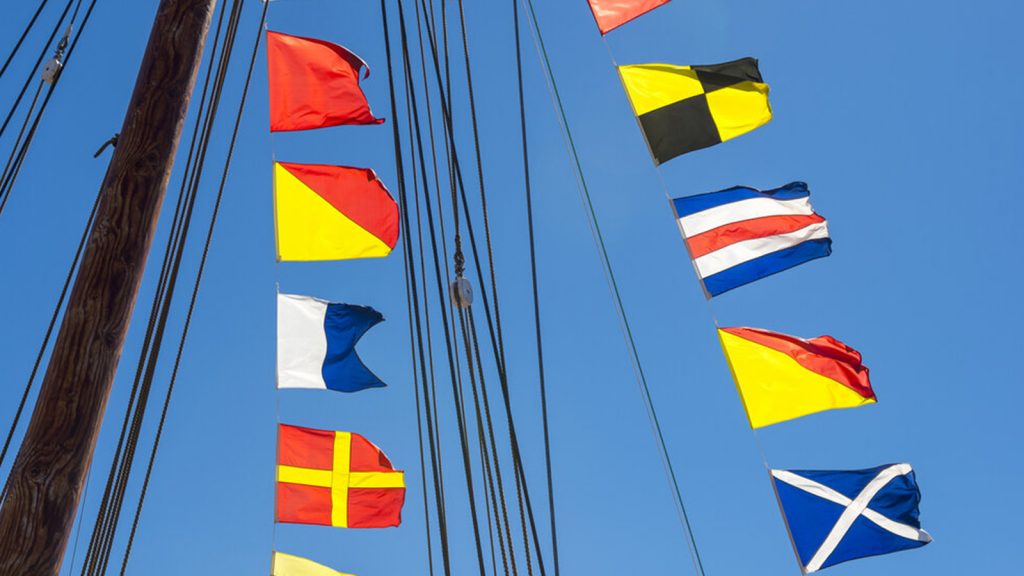
Nautical flags serve the purpose of communication in situations concerning navigation safety and individuals. They form an international code system enabling boats to signal to shore or for two boats to communicate with each other.
Individual flags have specific and standard meanings. These ones can be used in combination with another flag or alone. Using different nautical colored flags have a different meaning.
What are Nautical Flags?
Nautical flags, also known as maritime signal flags, are a set of flags and pennants used to communicate messages between ships and boats. Each flag represents a specific letter, number, or message, allowing vessels to convey information even when verbal communication is not possible.
The use of nautical flags dates back centuries and continues to be an essential aspect of seafaring traditions.
Nautical flags are compose of 26 square flags that represent the letters of the alphabet. There are also 10 numbered pendants, one answering pendant and three substitutes.
You will see nautical flags in a few colors because only a few flag colors are easily recognized:
Nautical Flags and Their Meanings
Importance of nautical flag meanings.
Understanding the meanings behind nautical flags is crucial for anyone involved in maritime activities.
Whether you’re a sailor, a boater, or simply fascinated by the sea, having knowledge of nautical flag communication enables you to interpret messages, navigate safely, and respond appropriately in different situations.
International Code of Signals
The International Code of Signals, also known as ICS, is a special set of rules that tells people who use nautical flags how to use them correctly. It helps sailors understand each other and communicate important messages by using these special flags in a specific way.
It was first established in the 19th century to facilitate communication and prevent misunderstandings among ships of different nationalities.
Over time, the code evolved and expanded to cover a wide range of messages and situations encountered at sea.
Within the International Code of Signals, each nautical flag represents a specific letter or number, as well as a set of predefined messages. These flags are combined to form words, phrases, and sentences, allowing vessels to spell out messages and communicate essential information.
The nautical flags in the International Code of Signals can be categorized into several groups, including alphabetic flags, numeric pennants, substitutes, repeaters, and special flags. Each category serves a specific purpose and carries distinct meanings when used in communication.
Individual Flag Meanings
Numeric pennants and their meanings.
Numeric pennants are a series of flags, each representing a number from zero to nine. These flags are used to communicate numerical information, such as coordinates, distances, or time. By combining different numeric pennants, vessels can convey precise numerical values, ensuring accurate communication between ships.
Letter flags and their meanings
Individual letters of the alphabet are represented by letter flags in the International Code of Signals. They are used to spell words and form sentences. Understanding the meanings assigned to each letter flag is critical for interpreting nautical flag messages and effectively communicating information.
Substitutes and repeaters in nautical flag communication
Substitute flags and repeater flags play important roles in nautical flag communication. Substitute flags are used to replace specific letter flags when they are not available or cannot be easily identified.
Repeater flags, on the other hand, are used to indicate that the preceding flag should be repeated. These flags ensure clarity and facilitate accurate transmission of messages.
Special flags and their purposes
The International Code of Signals includes several special flags that represent specific messages or commands. These flags convey information related to safety, medical assistance, maneuvering instructions, and more.
Understanding the meanings behind these special flags is crucial for maintaining safety and effective communication on the water.
Nautical Flags Meanings
It’s important to understand nautical flags and their meaning because they are valuable at sea in case of breakdowns in other communications systems (eg. radio) or in case of danger.
- One-flag signals are urgent or common signals.
- Two-flag signals are used for distress and maneuvering.
- Three-flag signals are for points of the compass, relative bearings, standard times, verbs, punctuation and also general code and decode signals.
- Four-flags are used mostly for geographical signals, names of ships, bearings, etc.
- Five-flag signals are used to relate time and position.
- Six-flag signals are used to indicate the main cardinal directions (N, S, E or W) in latitude and longitude signals.
- Seven-flags are used as signals for indicating longitude signals containing more than one hundred degrees.
Nautical flags are also used in nautical racing which signal to the competitors what they are supposed to do.
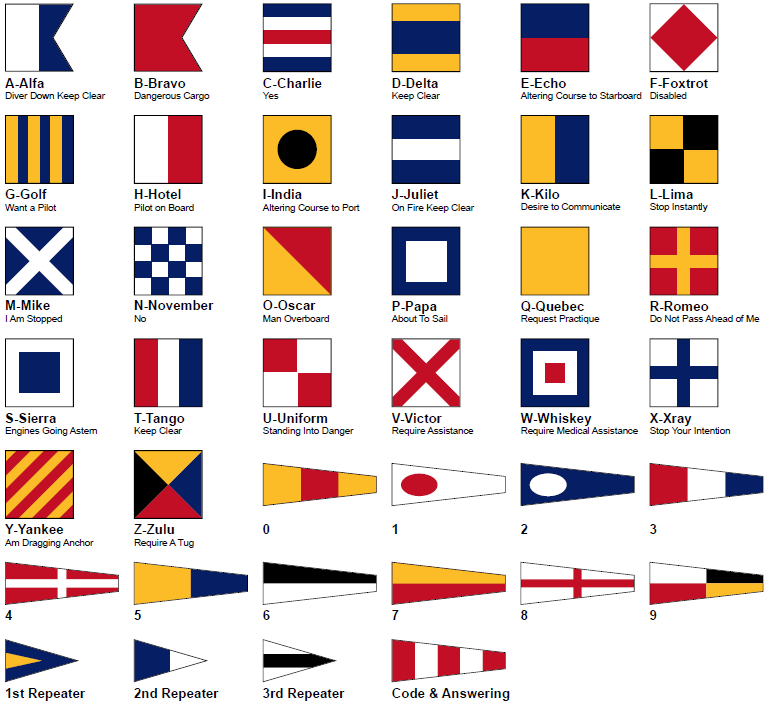
The Nautical Flag Alphabet
It is critical to understand that each flag representing a letter has a specific meaning.
International meanings for nautical flags:
- A: Alpha – diver down; I am undergoing a speed trial
- B: Bravo – carrying dangerous cargo
- C: Charlie – yes (affirmative)
- D: Delta – keep clear of me, I am manoevering with difficulty
- E: Echo – altering course to starboard
- F: Foxtrot – I am disabled, communicate with me
- G: Golf – I want a pilot
- H: Hotel – a pilot on board
- I: India – I am altering my course to port
- J: Juliet – vessel on fire keep clear
- K: Kilo – I want to communicate with you
- L: Lima – stop your vessel instantly, I have something important to communicate; Come Within Hail or Follow Me (Sailing Regatta)
- M: Mike – my vessel is stopped and making no way through the water; Mark Missing (Sailing Regatta)
- N: November – no (negative); Abandonment and Re-sail (Sailing Regatta)
- O: Oscar – Man overboard
- P: Papa – In port: All personnel return to ship; vessel is about to sail; At sea, fishing vessels might use this specific flag to convey the message “My nets have become entangled with an obstacle.”
- Q: Quebec – I request free pratique
- R: Romeo – reverse course
- S: Sierra – engines are going astern
- T: Tango – Keep clear; engaged in trawling. (International); Do not pass ahead of me. (Navy)
- U: Uniform – you are heading into danger
- V: Victor – require assistance
- W: Whiskey – require medical assistance
- X: X-ray – stop your intention
- Y: Yankee – am dragging anchor
- Z: Zulu – I require a tug
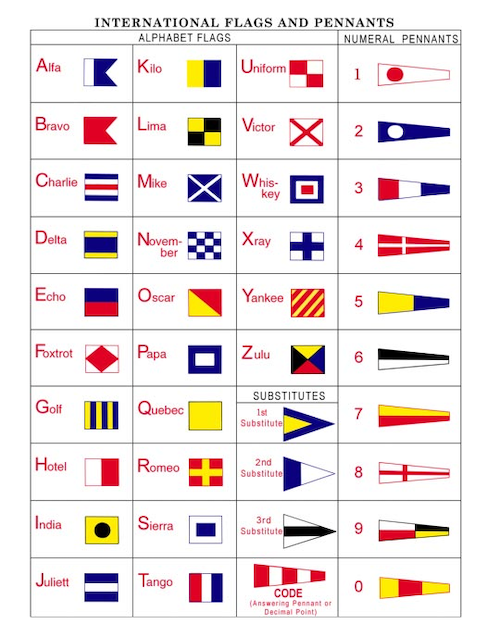
Solo or combined nautical flags have different meanings
Depending on the type of message, boats fly between 1 and 7 nautical flags. The combination of the O (Oscar) and W (Whiskey) flags, meanwhile, means “Man overboard. I require medical assistance”.
Signals with two nautical flags usually mean a certain problem of danger or maneuver. Three or more flags may include pendants and may indicate things such as compass points, time and position, geographic signals, geographic coordinates, and boat names.
Nautical Flags, sometimes the secret language of ships
While sailors around the world use nautical flags to communicate different scenarios, certain situations use secret language.
For example, the US Navy groups signals together in ways known only to its staff to communicate with its fellow ships.
NATO uses also the same nautical flags, with a few additional ones to warships, alone or in short sets to communicate various unclassified messages.
In yacht racing, the nautical flags have other meanings. These ones are solo or combined.
The P flag, for example, is employed as the “preparatory” flag to indicate an impending start, while the S flag indicates that a course has been shortened.
Nautical Flags to Buy
Interested in buying nautical flags to decorate your yacht? Whether you want to add a nautical flag pole, or you’re looking to replace an old nautical flag, we hope you find what you’re looking for!
Set of 50 Nautical Flags
We recommend this set of 50 (100% cotton) nautical flags. All flags are hand-made, so they can be quite smaller or bigger. Each flag is about 8 inches tall and 13 inches wide. All are printed on both sides. They give you a guarantee on color for life.
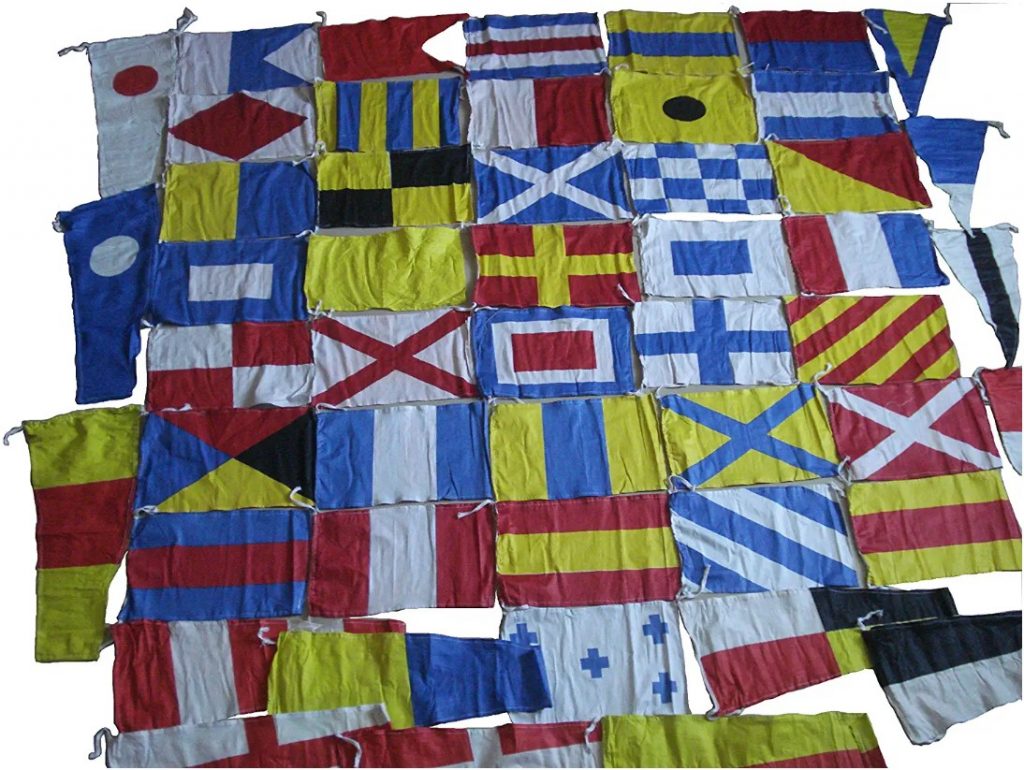
Maritime Signal Flags - 40 Different Decorative Flags - Over 40 Feet Long - Easy to Display
The flags are constructed of weather-resistant nylon cloth with double stitched seams. They are connected on a nylon chain with knots at both ends for convenient hanging.
These rectangular flags are 6″ x 9″, while pennant flags measure 6″ x 14″ or 6″ x 9″. The nylon cable is more than 40 feet long, with 7″ between flags and 36″ ties on either end.
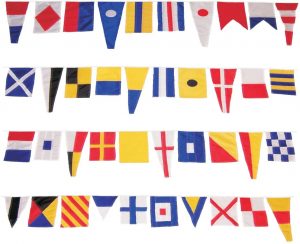
FLAGLINK International Marine Navy Signal Code Flag Set - String of 40 Flag - 40 Feet Long – Nautical Maritime Boat Ship Vessel Nautical Theme Decoration for Patry
Do you plan on throwing a big party on the boat and want to deck out the entire vessel in honor of the occasion? These nautical flags, which are less expensive than the previous ones, are an excellent choice for interior or outdoor decorations.
You may hang your ornamental flags in your front yard, garden, or patio, so that your family and friends can view the gorgeous holiday flag design from every aspect and vantage point. Because they are constructed of a water-resistant polyester fabric, they may be left outside for an extended period of time.
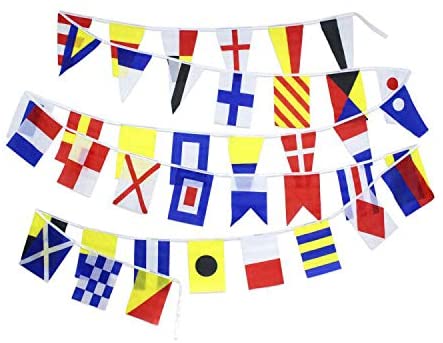
What nautical flags mean?
The purpose of nautical flags is to give ways and means of communication in circumstances involving the safety of navigation and people. Nautical flags are an international coding system used for a boat to indicate to land or for two vessels to signal to each other in situations involving the safety of navigation and people.
How many nautical flags are there?
There are 26 square nautical flags. Each of them symbolizes an international code term associated with the letters of the alphabet, such as Alpha, Bravo, Charlie, Delta, and so on.
What are nautical flags called?
Nautical flags are also known as international maritime signal flags, signal flags or boat flags.
How do you spell out messages using nautical flags?
Messages are spelled out using nautical flags by hoisting the flags in the correct sequence according to the International Code of Signals. Each flag represents a letter, and the combination of flags creates words, phrases, and sentences.
Are there any alternative systems to nautical flag communication?
While nautical flags are widely used for communication at sea, alternative systems such as radio communication, semaphore flags, and modern technologies like VHF radios and satellite communications also play a role in maritime communication.
Where can I learn more about nautical flag meanings?
To learn more about nautical flag meanings and communication, you can refer to resources such as official publications on the International Code of Signals, maritime museums, boating and sailing organizations, and online references that provide detailed information on nautical flags and their meanings.
Leave a Comment Cancel Reply
Your email address will not be published. Required fields are marked *
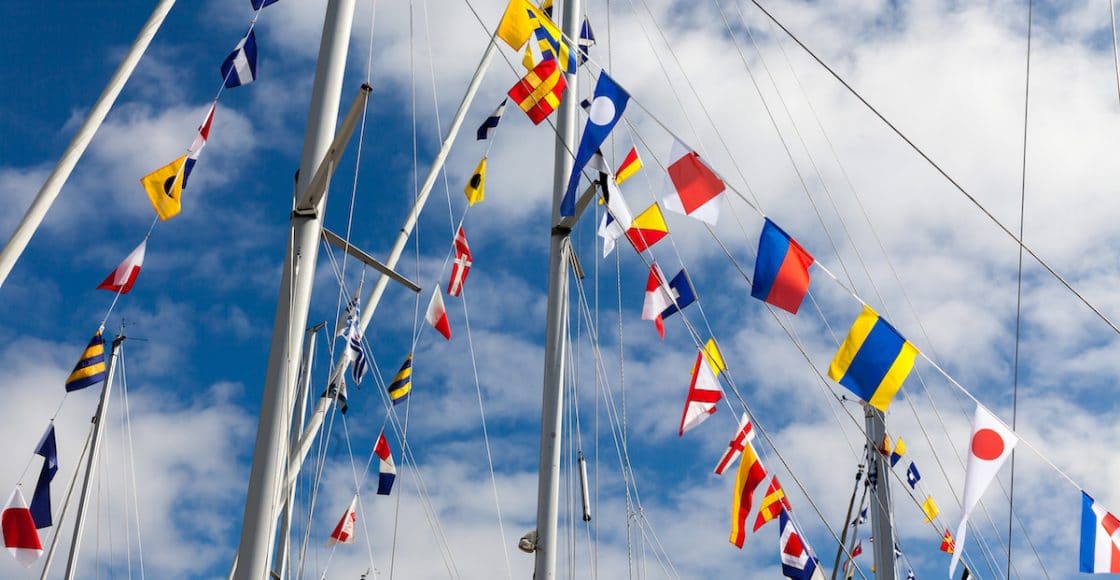
Understanding the Nautical Flags, Sailing Flags, & the Nautical Alphabet

Last Updated on June 9, 2023 by Boatsetter Team
Just as the marine electronics and lights on a boat help you communicate with your fellow cruisers, nautical flags and sailing flags are a language of sorts, too. They help alert others to maneuvers you’re making, for example, or an emergency. In certain combinations, they warn of bad weather. It all depends upon which flag—or flags—you see.
Here’s how to make sense of the nautical flag alphabet. This way, you understand the situation at hand when you’re next out on the water.
Explore Powerboat & Sailboat Rentals Near You
6 Tips for Identifying Nautical Flags
1. pay attention to the flag’s shape..
Most nautical flags are squares. Additionally, you’ll find some resembling triangles but with flat tips—a.k.a. pendants. These two shapes are the most common.
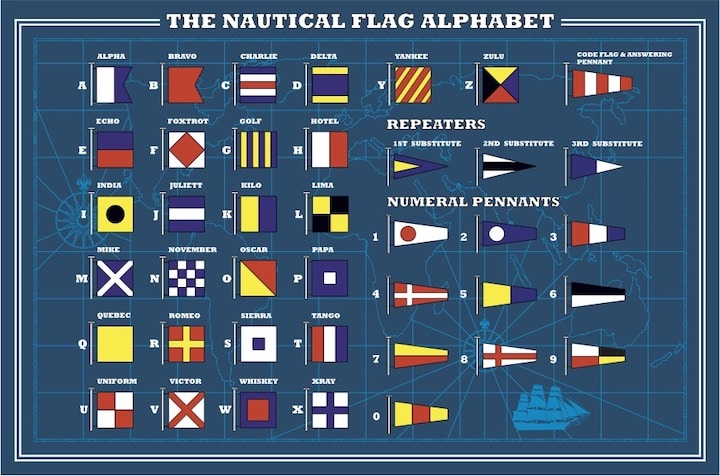
2. Learn the nautical flag alphabet.
Conveniently, for every letter of the alphabet, there’s an equivalent square nautical flag. Well, more accurately, each flag represents international code words like Alpha, Bravo, Charlie, etc., which correspond to alphabetical letters. The full list and their meanings:
- A – Alpha – diver down; keep clear
- B – Bravo – carrying dangerous cargo
- C – Charlie – affirmative (yes)
- D – Delta – keep clear, I am maneuvering with difficulty
- E – Echo – altering course to starboard
- F – Foxtrot – I am disabled, communicate with me
- G – Golf – I want a pilot
- H – Hotel – a pilot is onboard
- I – India – I am altering my course to port
- J – Juliet – vessel on fire, keep clear
- K – Kilo – I want to communicate with you
- L – Lima – stop your vessel instantly, I have something important to communicate
- M – Mike – my vessel is stopped and making no way through the water
- N – November – negative (no)
- O – Oscar – man overboard
- P – Papa – about to sail (when flown in port; at sea, fishing vessels use it to mean their nets are caught on an obstruction)
- Q – Quebec – I request free pratique (clearance to enter port due to no disease onboard)
- R – Romeo – reverse course
- S – Sierra – engines are going astern
- T – Tango – keep clear, I am engaged in trawling (if a fishing vessel; if a naval ship is flying this flag, it means do not pass ahead)
- U – Uniform – you are heading into danger
- V – Victor – I require assistance
- W – Whiskey – I require medical assistance
- X – X-ray – stop your intention
- Y – Yankee – I am dragging anchor
- Z – Zulu – I require a tug
3. Remember that the numbers on nautical flags have meanings, too.
When it comes to numbers, boaters use pendants. Ten different pendants represent the numbers zero through nine. A combination of flags denotes the numbers 10 and up.
4. Consider the color of the flag.
Nautical flags only use five colors:
Not coincidentally, each of these stands out against the sky, easily seen through binoculars or with the naked eye. You might see a solid-color flag or one with a combination of colors. For example, two red pendants means there’s a small-craft advisory.
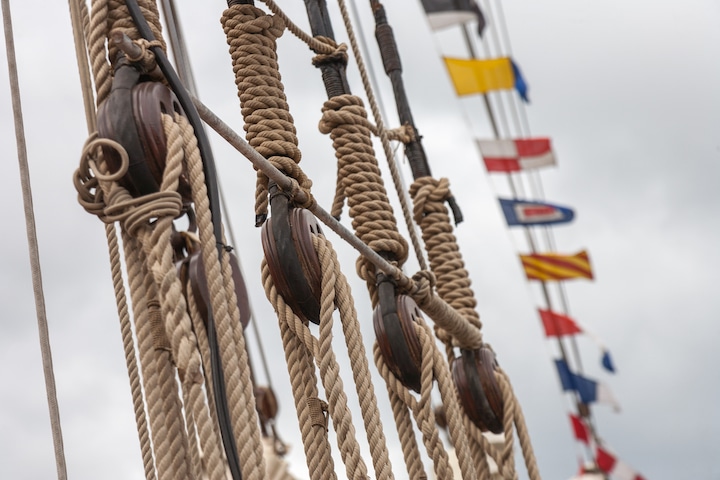
5. Tally the total.
Boats can fly up to seven flags in a row to convey certain messages.
- Solo flags are the previously mentioned international code words (Alpha for diver down, for instance).
- Two nautical flags flown together typically indicate distress or a maneuvering problem. A good example: Oscar and Whiskey flown together mean someone fell overboard and needs medical assistance.
- Three-flag signals can mean the points of the compass, among other things. Four-flag signals are ship names, while five are time and position. Six-flag signals indicate latitude and longitude, while seven mean longitude with more than 100 degrees.
6. Keep in mind that special languages exist.
Sometimes, the nautical flag alphabet is unique to certain situations. Regattas assign different meanings to a few flags, so that racers understand what’s happening. NATO and even the U.S. Navy do, too, with only their personnel knowing the meanings.
Ready to hit the water? Browse local boat rentals near you.

A journalist with more than 30 years’ experience, Diane M. Byrne is the owner of MegayachtNews.com, a daily website educating American superyacht owners, buyers, and their circles of influence about the leading builders, designers, cruising destinations, and more. She founded the website in 2007 as the first, and still the only, American-focused online media outlet exclusively covering this market. It features all-original content, for real stories of real interest.
Diane is additionally one of the most-sought-after journalists for expert editorial coverage and commentary about not only superyachts, but also general boating and yachting. Her byline appears in Boatsetter.com, DiscoverBoating.com, and the magazines Luxury Guide, Ocean, Yachting, and Yachts International.
Additionally, Diane is the Chair of the U.S. Superyacht Association, having been on the Board of Directors since 2015. Outside of yachting, she’s a trustee of Sempre Avanti, a non-profit resource supporting Italian and Italian-American individuals, businesses, and organizations in the United States and Italy.
Browse by experience

Explore articles

Living on a Boat: 5 Things You Need to Know

5 Incredible Sailboat Excursions You’re Missing Out On
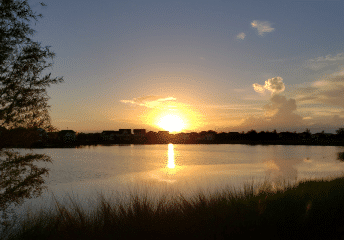
Lakes in Orlando for Boating

Bowriders: What is a Bowrider Boat?

- Find A School
- Certifications
- North U Sail Trim
- Inside Sailing with Peter Isler
- Docking Made Easy
- Study Quizzes
- Bite-sized Lessons
- Fun Quizzes
- Sailing Challenge

Nautical Flags: Origins, Meanings, and Resources
By: Zeke Quezada, ASA Learn To Sail , Nautical Trivia , Sailing History
Nautical flags fly high above anchorages in every popular spot in the Caribbean. Every person who charters a boat has also decided to get a custom burgee to explain that they have arrived. In all honesty, American Sailing has a few nice burgees that I have hoisted, so I am one of those people as well.
However, what do these flags mean, and where did they evolve from?
Nautical Flag Origins and History
Nautical flags have a rich history, and their evolution over time has been fascinating. Nautical flags have been used for centuries to communicate between ships at sea. They are essential tools for sailors to convey important information without the need for modern communication technologies.
The use of flags for communication between ships dates back to the 17th century. Back then, ships would use flags to signal their identities, affiliations, and intentions. Nautical flags were initially used in ancient military encounters to signal actions to other fleet members. In the past, flag communication was limited, and the primary use was to signal the need for a conference where more detailed instructions could be given. The Royal Navy’s Permanent Fighting Instructions, which comprised 45 mixed messages using 11 flags, directly resulted from signals developed during the Anglo-Dutch naval wars of the mid-1700s.
The use of nautical flags evolved, with new flags being introduced to communicate more specific information.
In the 19th century, the International Code of Signals was established to standardize the use of nautical flags. This code uses a combination of signal flags, alphabet flags, and numeral pennants to convey messages. Each flag represents a letter or a number, and the messages are spelled out by stringing together the appropriate flags.
Today, nautical flags are still used for communication between ships, but their use has expanded to include decoration and identification. For example, yacht clubs often use burgee flags to identify themselves, and boats may fly a particular flag to indicate their nationality or affiliation.
Nautical flags come in different shapes, sizes, and colors, each with a specific meaning.
Nautical Flag Uses and Meanings
- Communication – Nautical flags are used to communicate between ships, especially when modern communication technologies are unavailable or have failed. The International Code of Signals is a standardized system that uses nautical flags to communicate messages between ships. This system uses a combination of signal flags, alphabet flags, and numeral pennants to convey messages. Each flag represents a letter or a number, and the messages are spelled out by stringing together the appropriate flags.
- Decoration – Nautical flags are used for decoration, particularly in yacht clubs and marinas. Burgee flags are small triangular flags used to identify a particular yacht club or organization. They are typically flown from the masthead of a yacht or displayed in a prominent location. Many yacht clubs have their unique burgee design, often based on the club’s logo or emblem.
- Identification – Nautical flags are used for identification purposes. For example, the national flag of a particular country is often flown on ships registered in that country. This helps other ships identify the nationality of a particular vessel. Similarly, boats may fly a specific flag to indicate their affiliation or membership in a respective organization or group.
- Competitive Sailing – In competitive sailing, nautical flags communicate information to the sailors. For example, the race committee uses flags to signal the start and finish lines, any changes to the course, and penalties for rule violations. Sailors must understand the meaning of each flag to ensure they comply with the race rules.
- Tradition – Nautical flags are an important part of maritime tradition. For example, the practice of flying a flag at half-mast to honor a shipmate who has died dates back to the 17th century. Similarly, the tradition of saluting a passing ship by dipping your flag or burgee has been a part of nautical culture for centuries
Curious to study more about flags and their meanings?
Check out our Nautical Flags and Knots to Know – Laminated Chart. The ASA laminated flags and knots chart is a handy reference guide for any sailor. 8 1/2″ x 11″ laminated card stock.

Related Posts:
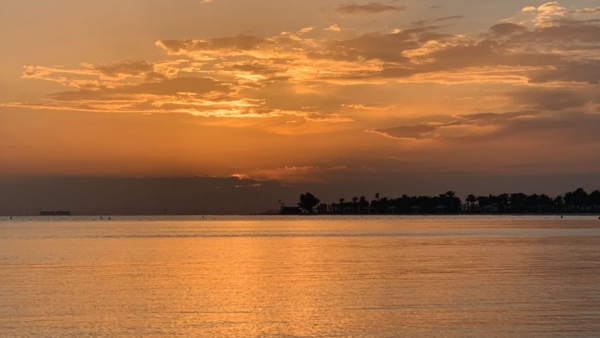
- Learn To Sail
- Mobile Apps
- Online Courses
- Upcoming Courses
- Sailor Resources
- ASA Log Book
- Bite Sized Lessons
- Knots Made Easy
- Catamaran Challenge
- Sailing Vacations
- Sailing Cruises
- Charter Resources
- International Proficiency Certificate
- Find A Charter
- All Articles
- Sailing Tips
- Sailing Terms
- Destinations
- Environmental
- Initiatives
- Instructor Resources
- Become An Instructor
- Become An ASA School
- Member / Instructor Login
- Affiliate Login
- Beyond New England
- Connecticut
- CT Shoreline
- Fairfield County
- Martha’s Vineyard
- New Hampshire
- Rhode Island
- Corks + Cocktails
- Just Desserts
- Savor the Shoreline
- Architecture
- Be Our Guest
- Coastal Color Palette
- Interior Design
- Real Estate
- Coastal Covers
- Coastal Creatives
- NECC BLOOM🌸

Indulge Your Senses at the Martha’s Vineyard Food & Wine Festival
A taste of the fork: bubbles & caviar vineyard tour, oceanic cottage | watch hill’s premier seaside escape, shepherds run | a sanctuary of wine and nature in south kingston, sundays by the sea | the jazz brunch experience at ocean house, westerly’s culinary and cultural renaissance: the cafe and the united theatre, from slope to soirée: elevated aprés ski entertaining, ski house etiquette: navigating the slopes of being the perfect guest, the dips at 30 devon street is a nantucket masterpiece, edgartown style, tranquility unveiled: delamar southport’s new spa for ultimate relaxation, get resort ready with kate leigh’s vibrant cabana capsule collection, broadlawn farm’s sweet initiative: combating human trafficking with chunk honey, stitching traditions: gabi rogers and the craft of elevated monograms at the preppy stitch, sea-inspired elegance: the nautical jewelry odyssey of patsy kane, 9 places to ski and snowboard in vermont, 9 places to ski and snowboard in connecticut.
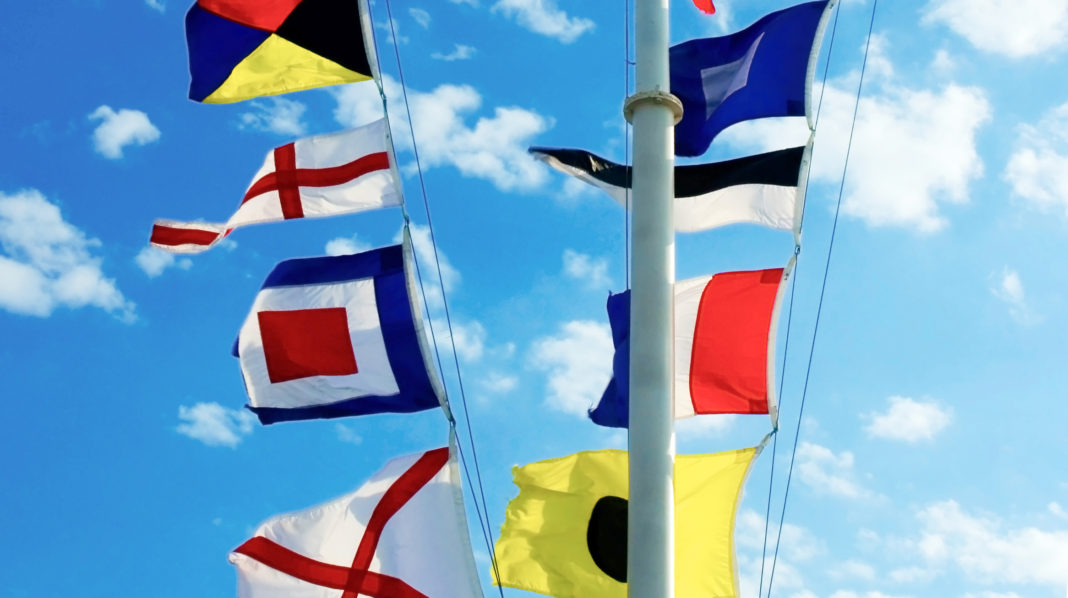
A Guide to Nautical Flags & Code Signals
Ahoy there! Have you ever wondered about those colorful flags you see fluttering on docks and seaside buildings? They’re called nautical flags, or burgees, and they have an interesting history. In the past, they were essential for communication between ships at sea, before radios and sonar came along. But nautical flags are more than just pretty decorations – they serve a practical purpose for boaters too.
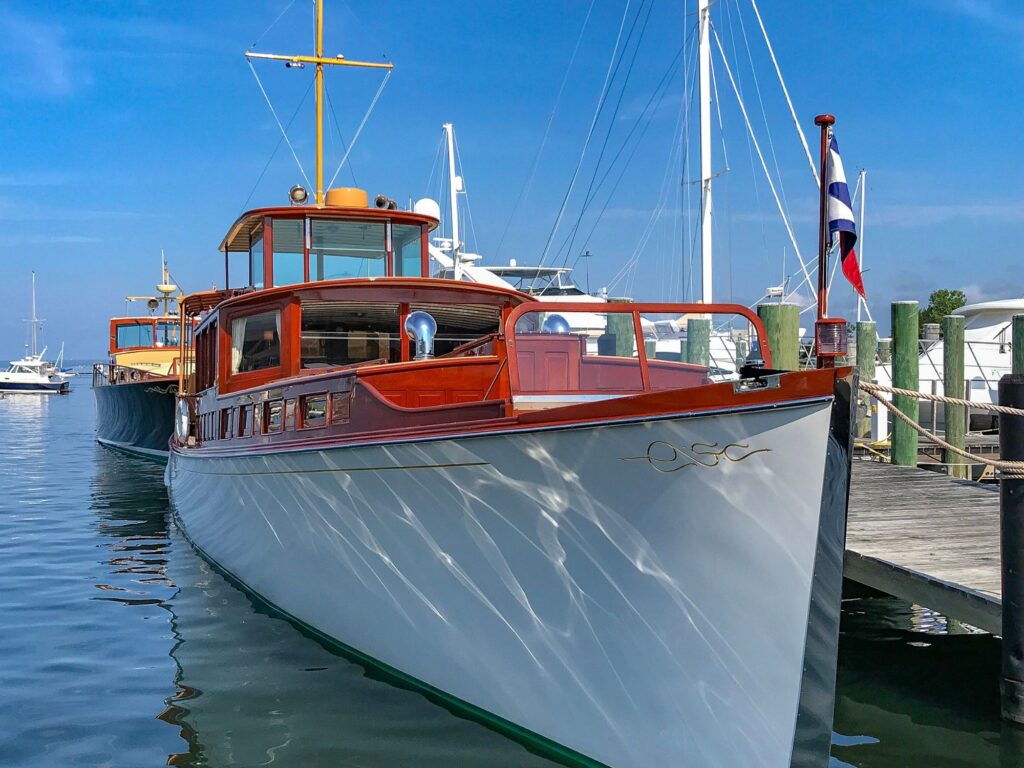
Nautical flags are part of an international code signaling system. These flags represent letters of the alphabet, numbers, and other signals, and they come in vibrant colors like red, blue, yellow, black, and white for maximum visibility. The combinations of these colors were carefully chosen to be easily distinguishable from afar. So, if you see flags that are red and white, yellow and blue, blue and white, or black and white, now you know why!
But nautical flags aren’t just for communication at sea. They also play a role in recreational boating. For example, there are flags that indicate the nationality of a vessel, the yacht club it belongs to, or even the personal interests of the boat owner. It’s like wearing a badge of honor on the water!
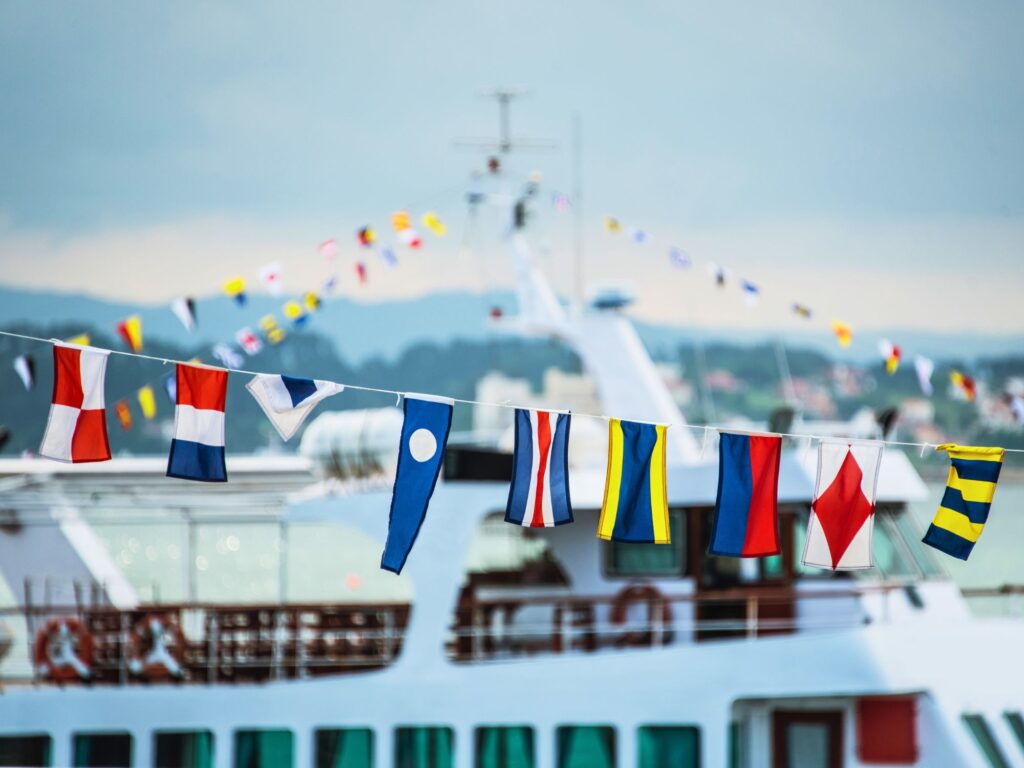
Speaking of flags, there are also important warning flags that boaters should be aware of. These flags, like the Hurricane Warning Flag and the Skin Diver Down Flag, send important messages to other vessels. They let everyone know about potentially dangerous weather conditions or the presence of divers in the area.
While technology has made nautical flags less necessary for everyday communication, it’s still a good idea for boaters to understand the basics. Who knows, maybe you can even use your newfound code skills to spruce up your beach house with some flag decorations! So, next time you spot those colorful fluttering flags, remember the fascinating history and practicality behind them. Happy boating!
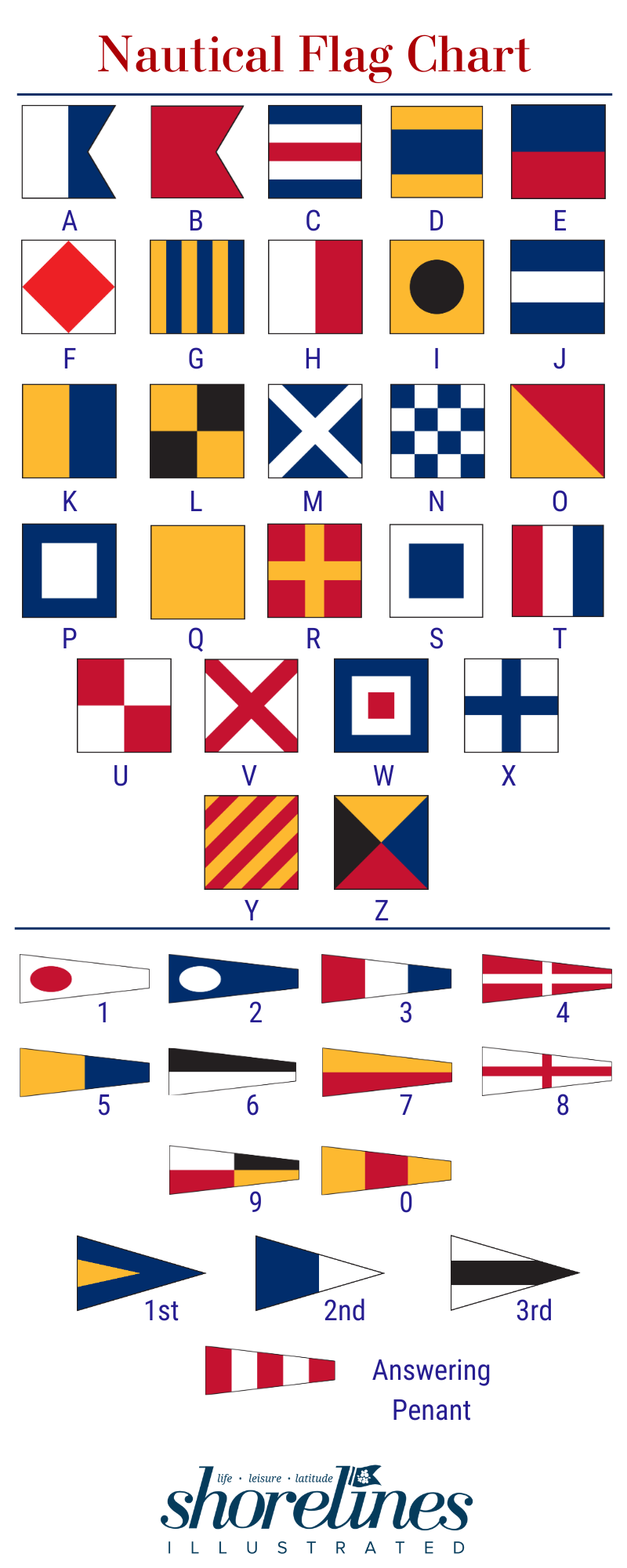
RELATED ARTICLES MORE FROM AUTHOR
Follow us on instagram @shorelinesillustrated, shepherds run | a sanctuary of wine and nature in south…, sundays by the sea | the jazz brunch experience at ocean…, stitching traditions: gabi rogers and the craft of elevated monograms at….

Nautical flags and meanings
- No Comments

Welcome to the intriguing world of nautical flags! Seafarers have used nautical flags for generations to communicate. Each flag symbolizes a letter or message with its own design and color scheme. These flags carry vital information including distress signals, identity, and directions in marine communication. Nautical flags are fun to learn about whether you’re a sailor or a landlubber. To help you decipher the sea’s hidden language, we’ll introduce you to some of the most essential and often-used nautical flags.

A: Alpha – Diver down (Small diving vessel); keep clear
Check this video quiz ↗

B: Bravo – Carrying dangerous cargo

C: Charlie – Yes (affirmative)
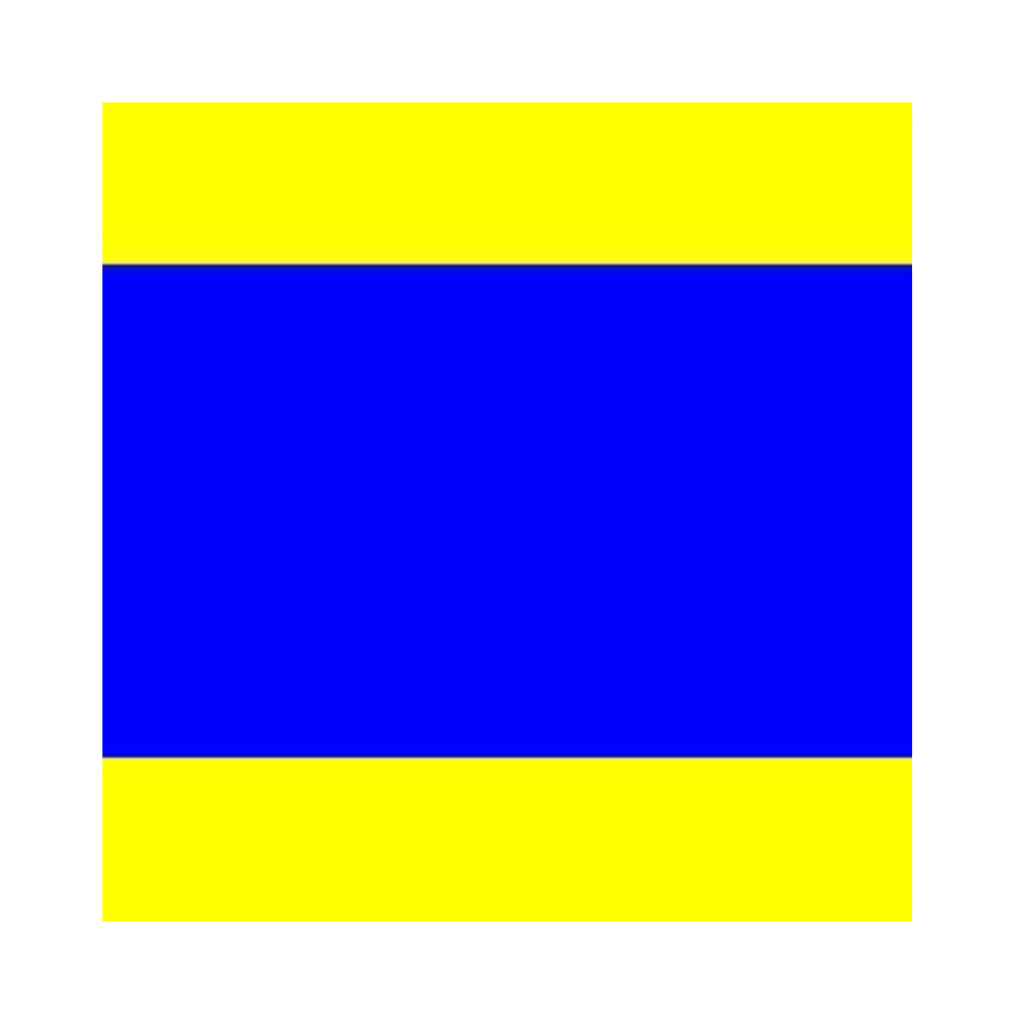
D: Delta – Keep clear of me, I am maneuvering with difficulty

E: Echo – Altering course to starboard

F: Foxtrot – I am disabled, communicate with me

G: Golf – I want a pilot
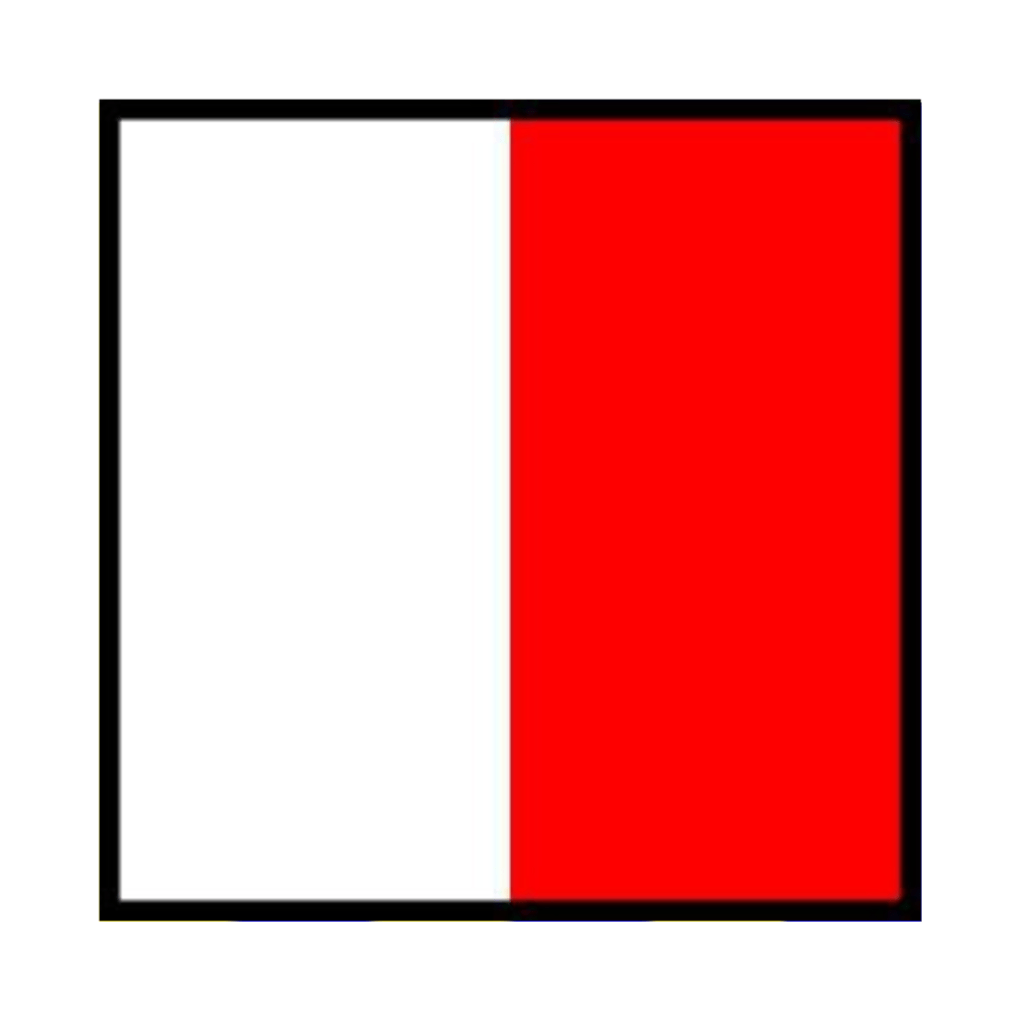
H: Hotel – A pilot on board

I: India – I am altering my course to port

J: Juliet – A vessel on fire, keep clear
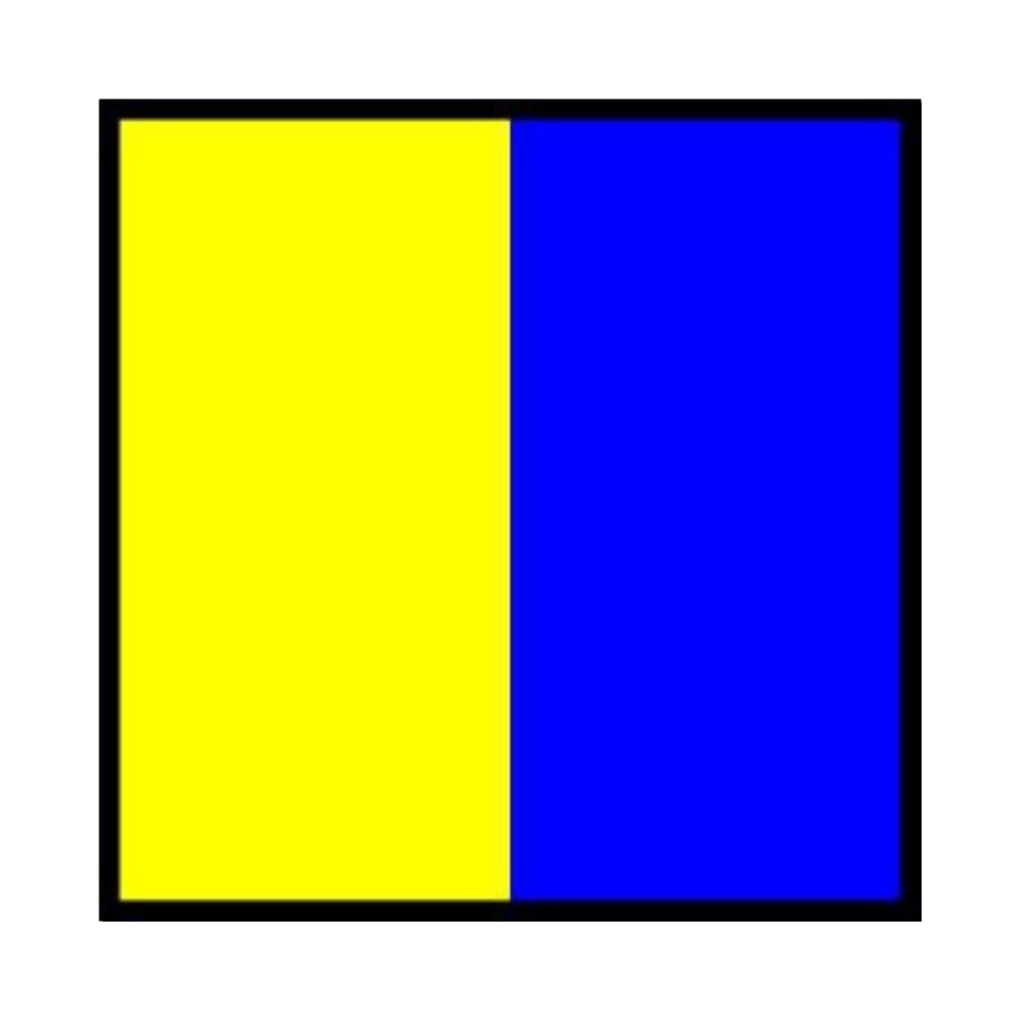
K: Kilo – I want to communicate with you
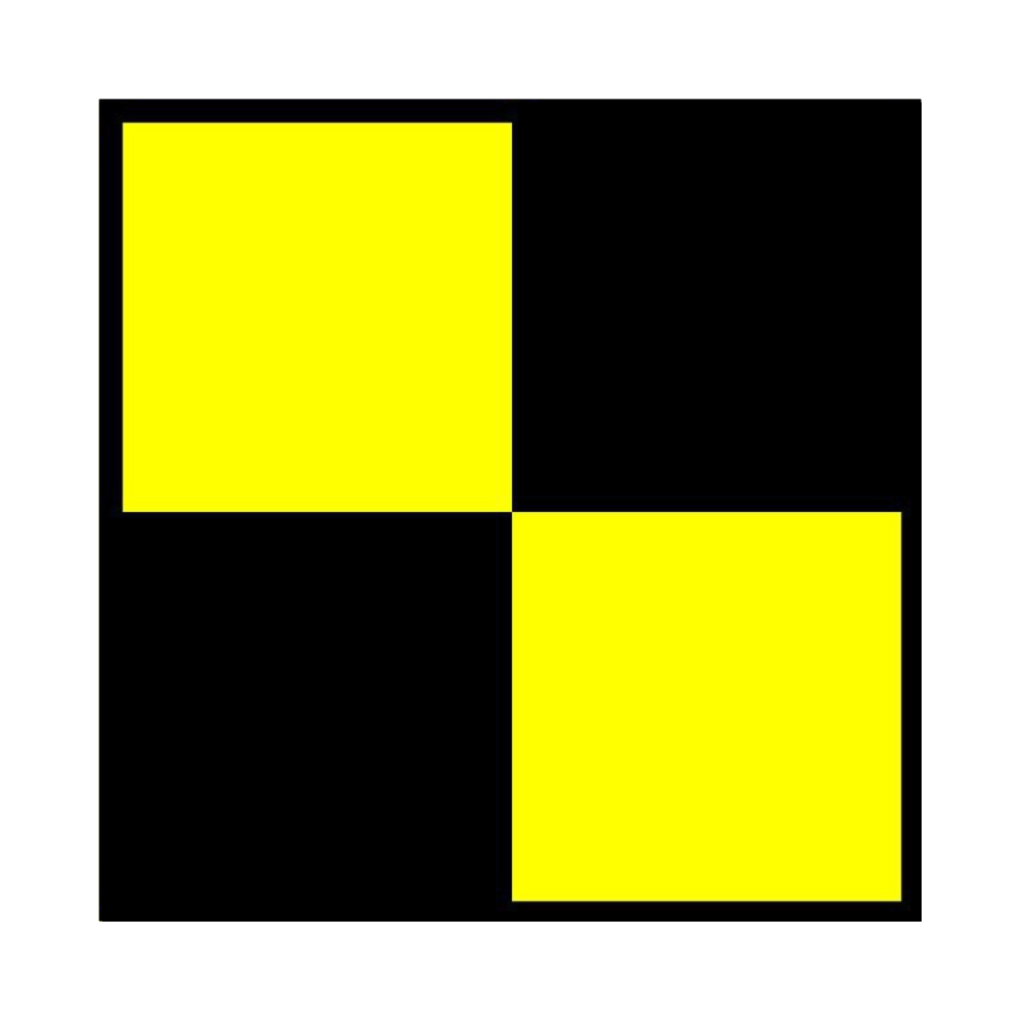
L: Lima – Sop your vessel instantly, I have something important to communicate; Come Within Hail or Follow Me (Sailing Regatta)

M: Mike – My vessel is stopped

N: November – No (negative)

O: Oscar – Man overboard

P: Papa – In port: All personnel return to the ship; the vessel is about to sail; At sea: It may be used by fishing vessels to mean: “My nets have come fast upon an obstruction”

Q: Quebec – I request free pratique

R: Romeo – Reverse Course

S: Sierra – Engines are going astern
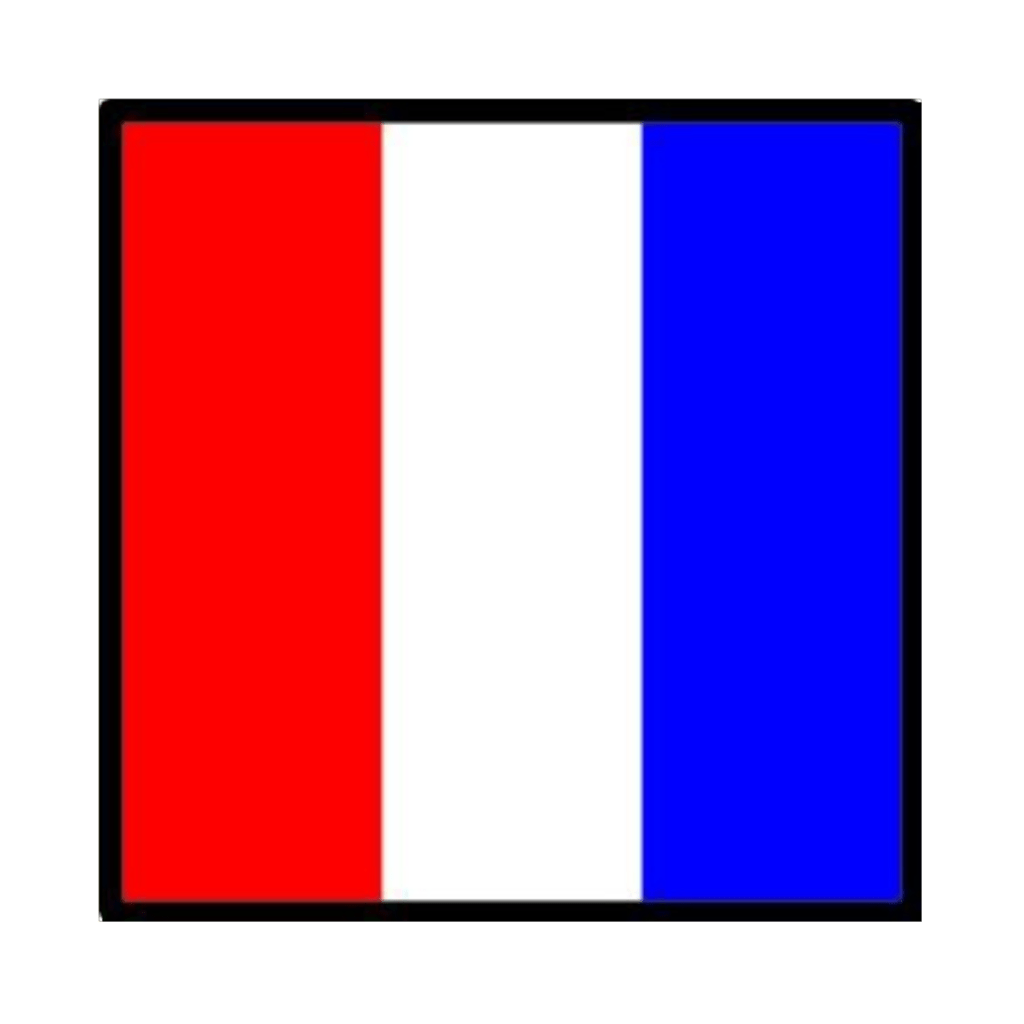
T: Tango – Keep clear; engaged in trawling (International); Do not pass ahead of me (Navy)

U: Uniform – You are heading into danger
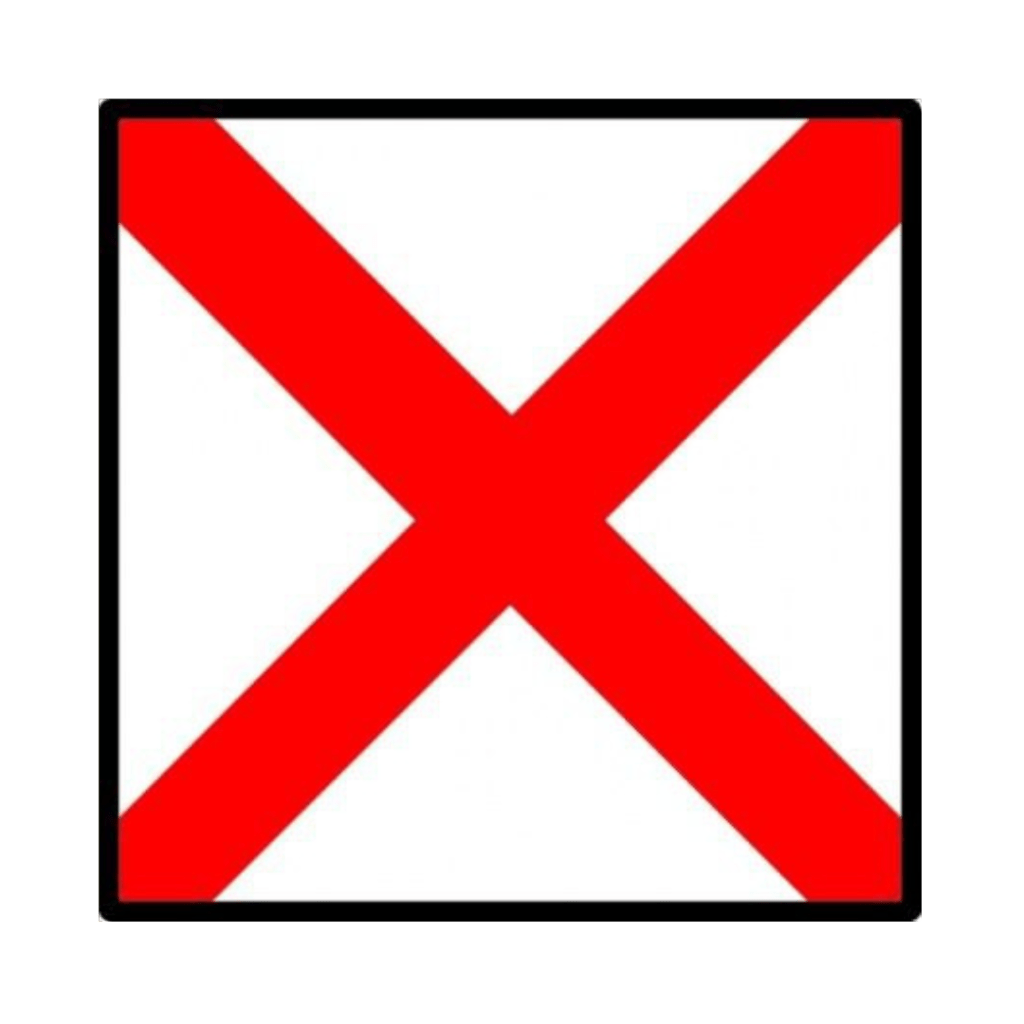
V: Victor – Require assistance

W: Whiskey – Require medical assistance

X: X-ray – Stop your intention

Y: Yankee – Am dragging anchor

Z: Zulu – I require a tug

▶ Follow Sailing Click on Youtube!
Yacht flags play an essential role in sailing, navigation, and communication among sailors. These flags are a part of the nautical flags category and are also known as nautical signal flags or sailing flags. Each flag has a specific meaning, and it is important for sailors to know them to communicate effectively and safely.
Nautical flags have been used for centuries to communicate messages between ships, and today they are still an important part of maritime tradition. Yacht flags are used for a variety of purposes, from signaling the vessel’s nationality to indicating its sailing status.
The International Code of Signals governs the use of nautical flags and sets out specific rules for their use. The code includes 26 alphabetical flags, 10 numerical pennants, and 3 substitute flags that are used to represent letters that are not included in the alphabet.
Yacht flags , in particular, are used to signal the boat’s identity, status, or intention. For example, a yellow and blue flag with a white anchor in the center is a signal for a vessel that is at anchor. A white flag with a blue square and a white cross in the center signals that the boat is a medical vessel or has a medical emergency on board.
Other popular yacht flags include the burgee, which is a triangular flag that represents the boat’s club or organization, and the courtesy flag, which is flown to show respect for the host country’s flag when sailing in foreign waters. The courtesy flag is often flown on the starboard spreader of the boat.
Navigation flags are another type of yacht flag used for signaling a boat’s movements or intentions. These flags are often used in racing or in other situations where it is important to communicate quickly and clearly. For example, a blue flag with a white diagonal stripe indicates that the boat is tacking, while a yellow and black flag signals that the boat is approaching a mark.
In addition to their practical uses, yacht flags are also an important part of maritime tradition and are often used for decorative purposes. Many sailors display their yacht flags on board their boats as a way of showing off their sailing accomplishments or their affiliation with a particular club or organization.
In conclusion, yacht flags are an important part of sailing and navigation, serving practical and decorative purposes. Knowing the meaning of each flag is crucial for effective communication and safety while on the water. So, next time you see a yacht flag waving in the wind, take a moment to appreciate the rich history and tradition behind it.
Leave a Review Cancel reply
You must be logged in to post a comment.
You may also like
Sailing spots.

Dalaman, Turkey – top places to visit

Yachting a Charter Boat Around Costa Brava, Spain
Yachting basics.


Sailing for beginners – 10 Questions and Concerns
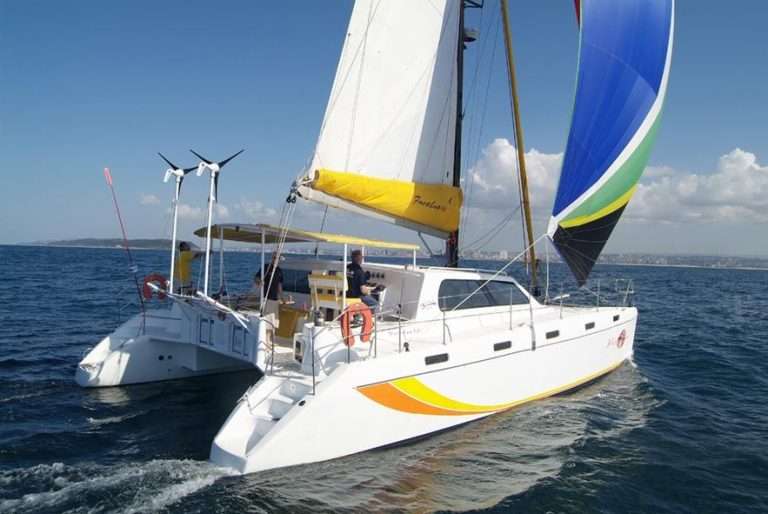
Powering Your Next Sailing Adventure with Renewable Energy
Sailing routes.

Sailing Route in Spain: from Barcelona along the Costa Brava

Sailing Around Sicily: A Voyage of Discovery
Yacht events.
No listings were found matching your selection. Something missing? Why not add a listing? .
Sailing News

Navigating 2023: A Calendar of the Year’s Remaining Major Sailing Races and Regattas

Ocean’s Embrace: Australian Sailor Survives Two Months Adrift in the Pacific
Faces in yachting.

Albert Einstein: The Yachtsman and His Beloved “Tümmler”

Hemingway and Pilar: A Love Affair with the Sea
Boat reviews.

- TOP Charter Deals (updated)
- Advertising and Promotion
- Privacy Policy
- Cookie Policy
Please note that some links on our site are affiliate links. This means we may earn a commission at no extra cost to you if you click on them and make a purchase. We recommend products because we believe they add value, not because of the commission we receive. Your support helps keep our site running. If you have questions, please reach out to us.
Privacy Overview
Change location, find awesome listings near you.
Nautical Flags and Their Meanings
International Code Flags (also see Multiple Flags Signal Codes )
Race Committee Flags
Yacht Club Officer Flags
Miscellaneous Flags
home | about | contact | advertising | privacy | link to us
Copyright © MarineWaypoints.com. All rights reserved.
The meaning behind nautical flags and how to understand them

When we were children, seeing a ship change its flag to one with a skull and bones would set our heart racing, as we knew pirates were on their way. Even if we have learnt about the existence of flags through movies, not everyone knows all the nautical flags used in the marine world and how to interpret them.
Nautical flags come in different shapes, sizes and colours. They can represent alphabet flags or numerical pennants , and combined they convey different meanings. If you are interested in the meaning behind nautical flags and would like to understand them, keep reading!
Despite all sorts of electronic navigation and communication gear aboard vessels, mariners still use nautical flags for communication in situations that require speed.
Shapes and types are essential for boating flags
Nautical flags are most common in the forms of squares , but you can also see pendants (triangular with a flat tip). There are 26 square nautical flags representing the letters of the alphabet. There are also 10 numbered pendants, one answering pendant and three substitutes.
On occasions you can see substitutes , which are triangles. However these are less common. Also, the only colours you will find in signal flags are black, blue, red, yellow and white. This is because these colors stand out well and can be seen with your own eyes on the horizon or through binoculars.
(Image from Discover Boating)
The Nautical Flag Alphabet
The international code of signals for the letters of the alphabet are as follow:
- A: Alpha – diver down; keep clear
- B: Bravo – carrying dangerous cargo
- C: Charlie – yes (affirmative)
- D: Delta – keep clear of me, I am maneuvering with difficulty
- E: Echo – altering course to starboard
- F: Foxtrot – I am disabled, communicate with me
- G: Golf – I want a pilot
- H: Hotel – a pilot on board
- I: India – I am altering my course to port
- J: Juliet – vessel on fire keep clear
- K: Kilo – I want to communicate with you
- L: Lima – stop your vessel instantly, I have something important to communicate; Come Within Hail or Follow Me (Sailing Regatta)
- M: Mike – my vessel is stopped and making no way through the water; Mark Missing (Sailing Regatta)
- N: November – no (negative); Abandonment and Re-sail (Sailing Regatta)
- O: Oscar – Man overboard
- P: Papa – In port: All personnel return to ship; vessel is about to sail; At sea: It may be used by fishing vessels to mean: “My nets have come fast upon an obstruction”
- Q: Quebec – I request free pratique
- R: Romeo – reverse course
- S: Sierra – engines are going astern
- T: Tango – Keep clear; engaged in trawling. (International); Do not pass ahead of me. (Navy)
- U: Uniform – you are heading into danger
- V: Victor – require assistance
- W: Whiskey – require medical assistance
- X: X-ray – stop your intention
- Y: Yankee – am dragging anchor
- Z: Zulu – I require a tug
Combined or individual flags convey meaning
Depending on the message, boats fly one flag or up to seven flags in a row. Besides the solo meaning seen above, combination of flags mean different things as:
- Combining the D (Delta) and V (Victor) flags mean “I’m maneuvering with difficulty and require assistance”.
- The J (Juliet) and L (Lima) flags mean “you’re running the risk of going aground”.
Also, using different amounts of nautical flags are valuable at sea for the safety of navigation in case of breakdowns in the radio or in case of danger.
- One-flag signals are urgent or common signals.
- Two-flag signals are used for distress or maneuvering.
- Three-flag signals are used for compass , relative bearings, standard times, verbs, punctuation and also general code and decode signals.
- Four-flags are used for geographical signals , names of ships…
- Five-flag signals are used to relate time and position of the ship.
- Six-flags are used to indicate main cardinal directions in latitude and longitude signals.
- Seven-flags are for longitude signals that contain more than 100º.
The secret language of ships
Even if the international flags are used to communicate in all scenarios, on occasions we see the use of secret languages with flags. For instance, the US Navy signals its staff to communicate between ships.
Also, NATO uses the same nautical flags with some additional ones for warships or in short sets to communicate with unclassified messages.
In yacht racing , nautical flags have different meanings. These can be solo or combined. For example, the P flag is used as the “preparatory” flag, and it indicates an imminent start. The S flag indicates that a course has been shortened.
Did you like this article? Let us know by sharing a comment on Facebook , Instagram or Twitter .

WE AND OUR PARTNERS USE COOKIES ON THIS SITE TO IMPROVE OUR SERVICE, PERFORM ANALYTICS, PERSONALIZE ADVERTISING, MEASURE ADVERTISING PERFORMANCE, AND REMEMBER WEBSITE PREFERENCES. BY USING THE SITE, YOU CONSENT TO THESE COOKIES. FOR MORE INFORMATION ON COOKIES INCLUDING HOW TO MANAGE YOUR CONSENT VISIT OUR COOKIE POLICY .

SailingEurope Blog - Sailing, Yacht Charter and Beyond
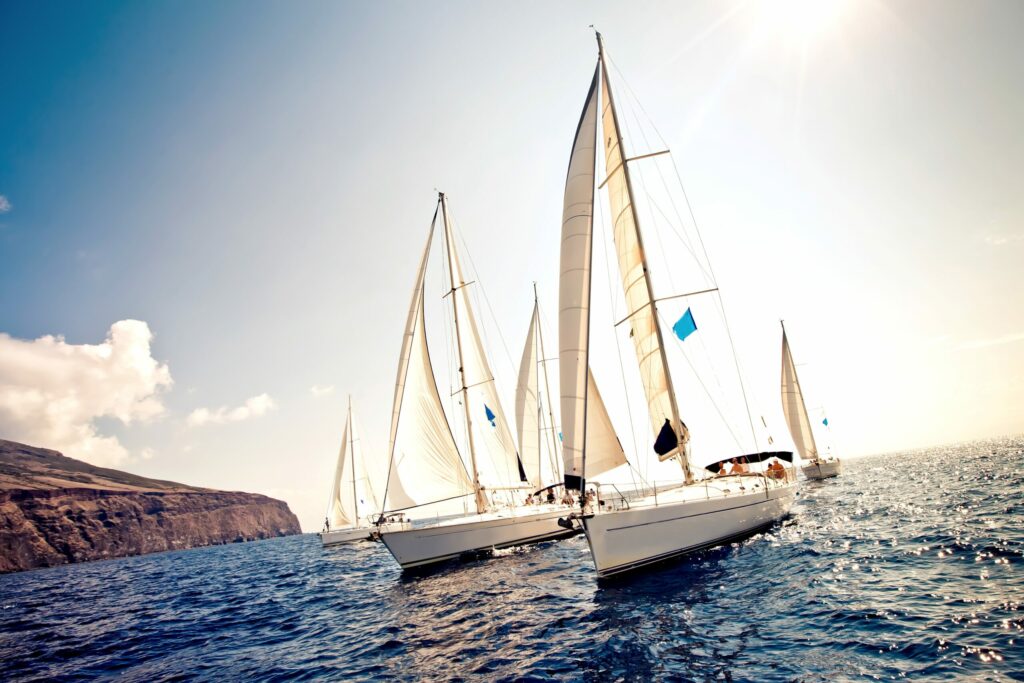
Nautical Flags and Their Meaning: What To Know As a Sailing Beginner?
All those who have been at least once on the dock or a pier probably noticed a large number of different flags hanging from the flagpoles. Those nautical flags are not just there to show you from which country is the boat or just for a decoration purpose. Moreover, those nautical flags are an International Code of Signals whose main purpose is to provide different ways of communications in different nautical situations. Therefore, they can be used for communication between two sailboats or yachts to signal each other, or for a signalisation between boat and the shore.
History of Nautical Flags
Nautical flags were originally used for communications among comrades during military entanglements. What started as a limited communication system evolved over centuries into a comprehensive, internationally-recognized signaling system functional for military and non-military purposes. Recreational vessels also use nautical flags. Moreover, as well as code signal flags to identify themselves and to communicate with other ships. Sailing flags are an internationally-recognized means of communication from ship to ship while out at sea. Moreover, code signal flags can be used alone or in combination with one another to send messages while nautical boating flags share other information about a vessel such as where it is from and its purpose for being on the water.
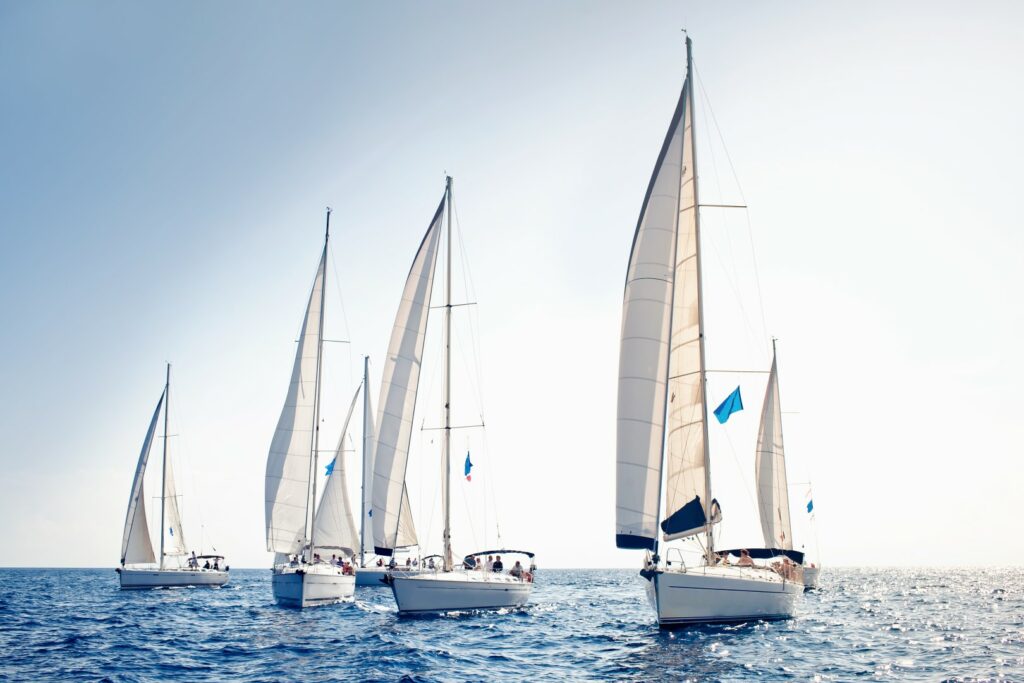
Military Origin
Maritime flags were originally used in ancient military encounters where flags signaled other fleet members to take specific actions. Early signal flag communications were limited. Therefore, the primary use was to signal the need for a conference where more detailed instruction could then be provided.
In the mid-1700s, more elaborate signals were developed during Anglo-Dutch naval wars. It resulted in the Royal Navy’s Permanent Fighting Instructions comprising 45 mixed messages using 11 flags. In 1738, Mahé de la Bourdonniase, a French officer, developed the first numerical flag code. It served as the basis for later flag-hoist signaling. Moreover, he numbering system vastly increased the combinations of communications a ship could make to 1,000 using three flags.
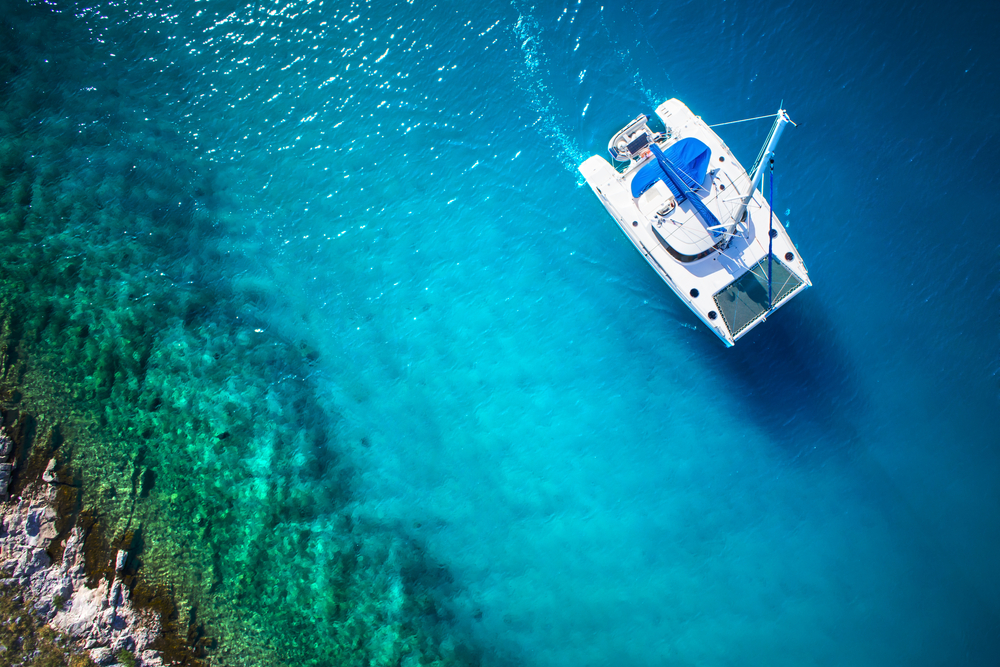
Signal Book for Ships of War
Richard Earl Howe, First Lord of the Admiralty in 1783, contributed by revising the French system to include repeater pennants as well as control flags. These modifications led to the 1799 Signal Book for Ships of War . Additionaly, it broadcasted use of individual flag designs that were used by the Royal Navy through the Napoleonic Wars and War of 1912. The system expanded further. With Popham’s Telegraphic Signals or Marine Vocabulary to include 6,000 phrases and 60,000 words.
In 1797 the United States first numerical code system, Instructions, Signals, and Explanations Ordered for the United States Fleet, was published. The first commercial book of signals, Code of Signals for the Merchant Service , was published in 1817. The author is Captain Frederick Marryat of the Royal Navy. J.R. Parker’s American Signal Book for the Use of Vessels Employed in the United States Naval, Revenue, and Merchant Service was created for government use in non-tactical communications. Parker revised the signal book until 1856, as technological advances had rendered such a signal system obsolete. The British Board of Trade then began creating an improved code. It will later become the International Code of Signals .
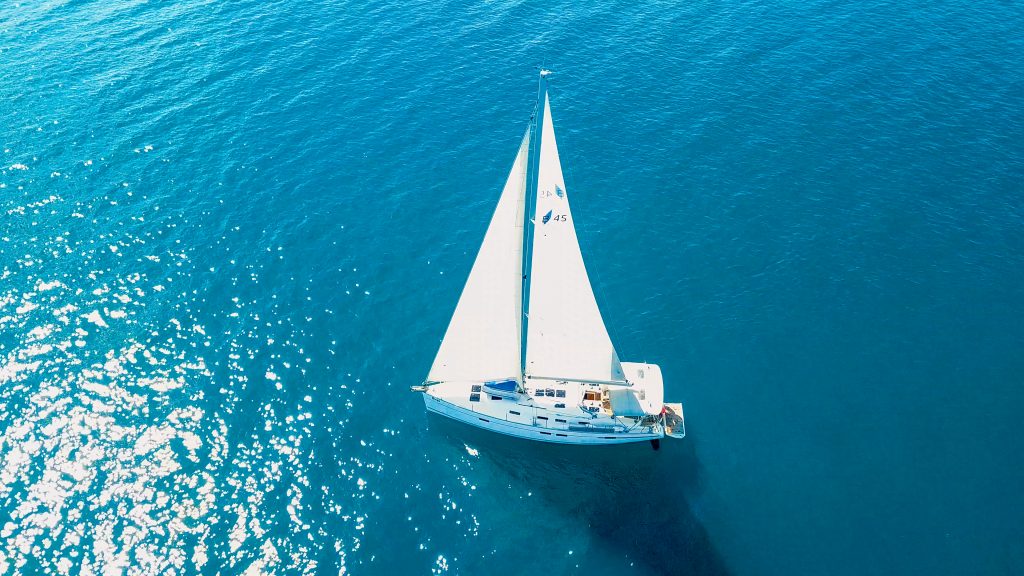
International Code Signals
The first International Code was made in 1855 and published in 1857. British Board of Trade was responsible for it and it contained 70,000 signals, 17,000 messages, and used 18 flags. Subsequent revisions were made to the Code during the International Radiotelegraph Conference of Madrid in 1932. Six more flags were added for different languages including French, Italian, German, Japanese, Norwegian, and Spanish. In 1947, it was determined that the Inter-Governmental Maritime Consultative Organization (IMO) should have responsibility over the Code. In 1969, more flags were added to accommodate the Greek and Russian languages. Each alpha-numeric signal flag was assigned meaning under the International Code.
When are Nautical Flags Used and Who Uses Them
Every boat out at the sea uses nautical flags. Either if it is navy boat, a sailboat or fishing vessel, maritime flags are neccessity of every boat. Every signal flag has it’s own unique meaning. But there are 3 different languages that sailing flags speak . And it differs depending if you’re in a sailing reggata , if you’re in the navy or something else. Moreover, the maritime flags used in all three langues are the same but in different context they can mean different things.

The point of using the flags is to clear up the communication path between sailors. That path can often be filled with language barriers or curtural differences that can lead to misscommunication. Signal flags signal your status, warning or need to a ship without a chance of misinterpretation.
People use nautical flags to express a status, warning or a need. Each flag does have it’s own letter but it is rarely used for spelling. Every flag has it’s unique meaning and those signals are ones most common out at sea. Therefore, use for spelling emerges in rare occasions. Also, if there’s the language barrier, the spelling wouldn’t be very useful.
Nautical Alphabeth and Meaning of Nautical Flags
The sailing beginners need to know that each flag in the group of different colored and shaped flags has a different meaning. Moreover, people use use nautical flags in combination with another flag or alone. In case of danger or breakdowns in communications systems , nautical flags and the knowledge of their meanings can be very helpful and valuable.
A: Alpha – I have a diver down; keep clear.
B: Bravo – I am taking in or carrying dangerous cargo.
C: Charlie – „Yes“ or „Affirmative“ , Sailing Regatta – Change of Course
D: Delta – I am maneuvering with difficulty; keep clear.
E: Echo – I am altering my course to starboard.
F: Foxtrot – International code: I am disabled. Communicate with me. Aircraft carrierers : Flight Operations underway
G: Golf – I require a pilot. When made by fishing vessels operating in close proximity on the fishing grounds it means: “I am hauling nets”
H: Hotel – I have a pilot on board.
I: India – International code: I am altering course to port. Navy code: Coming alongside. Sailing Regatta: Round the Ends Starting Rule.
J: Juliet – I am on fire and have dangerous cargo; keep clear.
K: Kilo – I want to communicate with you.
L: Lima – International code: Stop your vessel instantly. Sailing Regatta: Come within hail or follow me.
M: Mike – International code: My vessel is stopped and making no way through the water. Sailing Regatta: Mark Missing.
Second part:
N: November – International code: No or negative. Sailing Regatta: Abandonment and Re-sail.
O: Oscar – Man overboard.
P: Papa – In port: All personnel return to ship; the vessel is about to procede to sea. At sea: Fishing vessels can use it: “My nets have come fast upon an obstruction”.
Q: Quebec – International code : Ship meets health regulations; request clearance into port. Navy code: Boat recall; all boats return to ship.
R: Romeo – International code : None Navy code: Preparing to replenish (At sea). Ready duty ship (In port).
S: Sierra – International code : Moving astern. Navy code: Conducting flag hoist drill. Sailing code: Shorten course.
T: Tango – International code : Keep clear; engaged in trawling. Navy code: Do not pass ahead of me.
U: Uniform – You are running into danger.
V: Victor – I require assistance.
W: Whiskey – I require medical assistance.
X: X-ray – International code : Stop carrying out your intentions and watch for my signals. Sailing code: Individual recall.
Y: Yankee – International code : I am dragging anchor. Navy code: Ship has visual communications duty. Sailing code: : Wear Life Jackets
Z: Zulu – International code : I require a tug. Sailing code: 20% scoring penalty
Other important nautical flags
Code/Answer – International code : Message is understood. Navy code : Flag that follows is from the International Code of Signals. Sailing code : Postponement.
First substitute – International code : Substitute for the first flag in this hoist. Also “repeats” the first flag or series of flags in this hoist Navy code : Absence of flag officer or unit commander Sailing code : General recall.
Second Substitute – International code : Substitute for the second flag in this hoist. Navy code : Absence of chief of staff.
Third Substitute – International code : Substitute for the third flag in this hoist. Navy code : Absence of commanding officer.
Forth substitute – Navy code : Absence of civil or military official whose flag is flying on this ship.
Now when you know some facts about nautical flags, try this International Code of Signals Flags Quiz .
Can you guess what picture below says?

3 thoughts on “Nautical Flags and Their Meaning: What To Know As a Sailing Beginner?”
You’re absolutely correct! 🙂
No, I cannot guess what the picture says. Where is the answer?
Above a bravo flag. Tie pin. Red triangle on top, white triangle on bottom, blue triangles on right and left.
Leave a Comment Cancel Reply
Your email address will not be published. Required fields are marked *
Save my name, email, and website in this browser for the next time I comment.
This site uses Akismet to reduce spam. Learn how your comment data is processed .

Have you ever noticed those colorful squares, triangles and pennants waving in the wind on sailboat masts and boat sterns? While pretty at a boat slip rental or on the water, they’re more than just an aquatic adornment.
Developed in the 1800s, the nautical flag system is known as the International Code of Signals. It was designed as a way for two ships to signal each other or to send a signal to the shore. Back then, there weren’t VHF radios, and it’s awfully hard to communicate from several miles away on the water. Think of it as a nautical form of texting – but with flags instead of emojis.
The system consists of 26 flags that represent a letter of the alphabet and an international code word. Flags have color schemes of blue, black, red, yellow and white. These colors were chosen because they stand out well and are easy to see at a distance. Flags can be flown one flag at a time or up to seven in a row, depending on the message you’re trying to convey. There are also 10 pennant-style flags for the numbers 0 through 9. For larger numbers, you would use more flags.
If you’re heading out from your private boat dock rental, it’s nice to know what these flags mean. Keep reading to check out common nautical flags, what they mean and when to fly them.
Nautical Flag Meanings
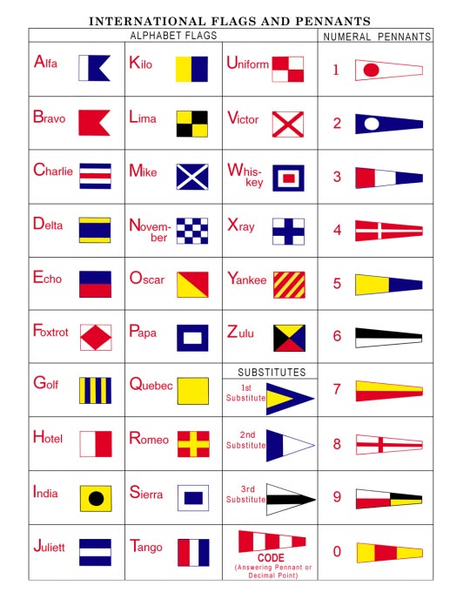
Bravo – Dangerous cargo
Charlie – Yes/Affirmative
Delta – Keep clear
Echo – Altering course to starboard
Foxtrot – Disabled
Golf – I need a pilot or I am hauling nets
Hotel – I have a pilot on board
India – Altering course to port
Juliet – On fire
Kilo – I would like to communicate with you
Lima – Stop now
Mike – I am stopped and not making headway
November – No/Negative
Oscar – Man overboard
Papa – Report on board, vessel is about to sail
Quebec – Vessel is healthy, request clearance into port (for international entrance)
Romeo – Do not pass ahead of me
Sierra – Engine going astern
Tango – Keep clear
Uniform – You are running into danger
Victor – I need assistance
Whiskey – I need medical assistance
Xray – Stop and watch for my signal
Yankee – Dragging my anchor
Zulu – I need a tug
Multiple Flag Signals
When more than a common command or warning is needed, multiple flags can be used.
- One flag is for common signals or warnings.
- Two flags are usually for distress signals.
- Three flags indicate compass points, relative bearings, punctuation and general code and decode signals.
- Four flags are for geographical signals, names of ships and bearings.
- Five flags relate time and position.
- Six flags are for north, south, east or west in latitude and longitude.
- Seven flags are for longitude signals with more than 100 degrees.
Two-Flag Signals
- DV – I am drifting.
- UM – The harbor is closed to traffic.
- PD – Your navigation lights are not visible.
- JL - You’re running the risk of going aground.
- BR – I need a helicopter.
Diver Down Flag
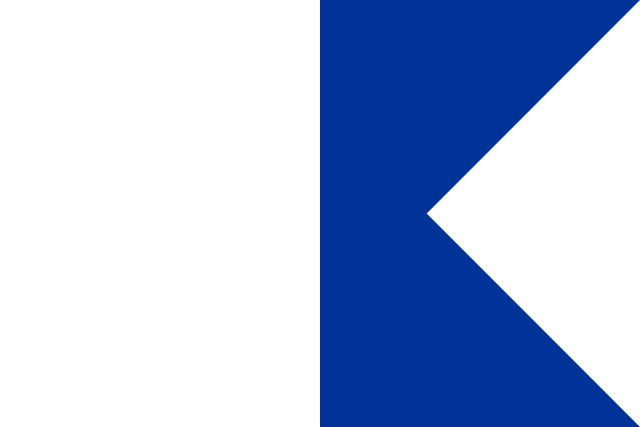
Photo: Wikimedia
Other nautical flags include the national ensign, yacht club burgee, sailing regatta flags and hurricane warning flags that indicate the area is expecting winds of 74 mph or higher.
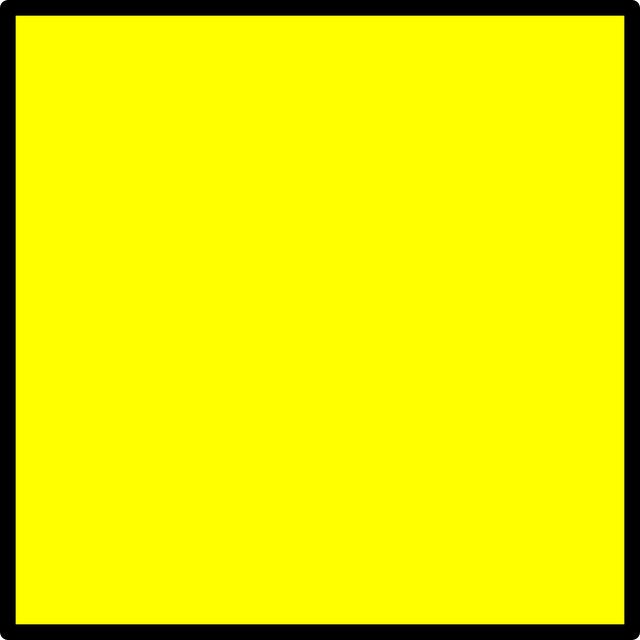
Photo: Pixabay
As a recreational boater, you may never need to use the majority of these marine flags as you come and go from your private boat slip rental. But knowing what they mean can be helpful out on the water, such as if you were to need assistance or if you were traveling internationally. For example, boaters navigating from Florida to the Bahamas by boat are required to fly the yellow Q flag (pictured above) when entering port.
Hopefully this has helped shed some light on the various nautical flag meanings and uses. Stay safe out there!


Boat Flags, Nautical Flags and Marine Flags: Types and Meanings
Olivia benjamin.
- July 24, 2023
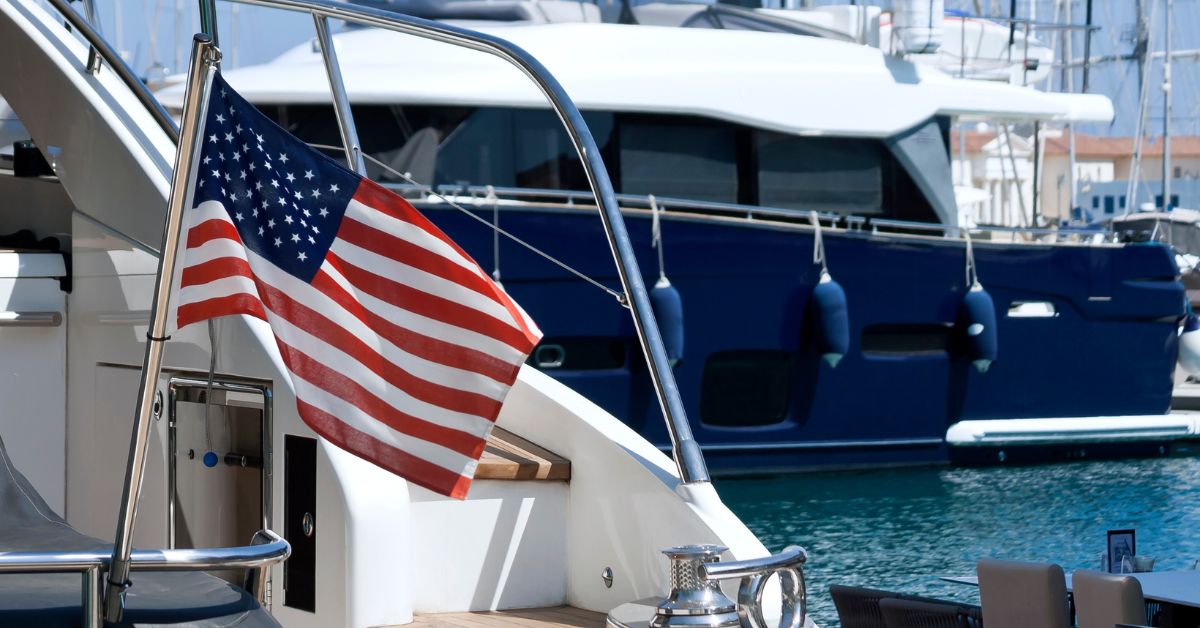
Boat flags are colorful and symbolic signals that serve multiple purposes on boats. The purpose of boat flags is to communicate messages and signals to other boaters, marine authorities, and the general public.
They indicate various important information such as the boat’s nationality, the presence of dangerous cargo, the name of the ship or yacht club, geographical signals, and much more.
Additionally, boat flags are often used as decorative items, contributing to the coastal décor of the boat. They can showcase the personality of the boat’s owner or represent a sailing organization. Boat flags are a great way to personalize your nautical vessel and have some fun along the way.
Types of Boat Flags
1. american flags on boats.
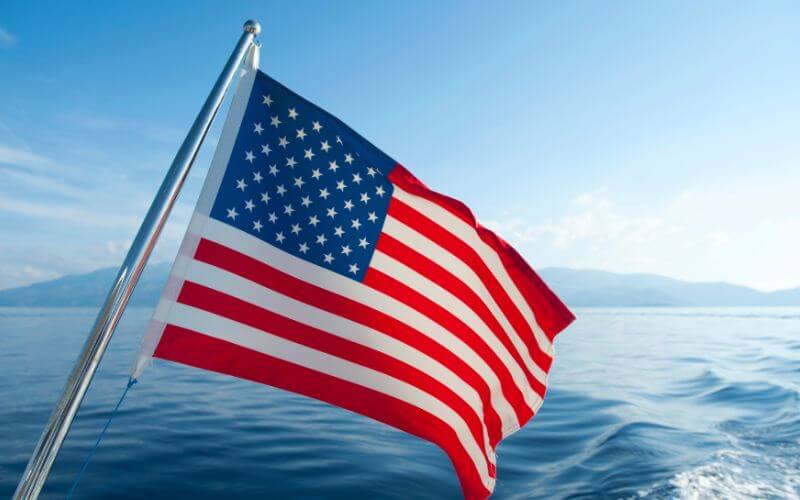
When it comes to displaying national pride and patriotism on the water, American flags are a common sight on boats. Not only does flying the American flag on a boat showcase a love for the country, but it also adheres to maritime customs and traditions.
Whether a small recreational vessel or a large yacht, displaying the US flag allows boat owners to demonstrate their allegiance and honor the values the flag represents.
The U.S. Yacht Ensign is a variation of the American Flag which is used in lieu of the traditional American Flag on yachts that are only traveling with U.S. waters.
History of the American Flag on Boats
The history of the American flag on boats is rooted in the evolution of nautical flags and their significance in communication between ships. As early as the 19th century, flags were used to convey messages and identify ships at sea.
With its iconic red, white, and blue design, the American flag became an important symbol of national pride and patriotism. It was incorporated into the flag communication system , allowing ships to display allegiance and send messages to fellow vessels.
Over the years, regulations and guidelines were established for flying the American flag on boats. These regulations ensure that the flag is displayed with the respect and dignity it deserves. Using the U.S. flag on boats has become standard on military vessels, recreational boats, and yachts.
Regulations for Flying an American Flag on a Boat
When displaying the American flag on a boat, specific regulations and guidelines should be followed to ensure the flag is treated with proper respect and dignity. These regulations help maintain the integrity of this symbol of national pride and patriotism.
Firstly, Flag sizes for boats need to match their size and style. Here are some guidelines:
The yacht ensign should be the largest flag on the boat regardless if it’s a power boat or a sailboat. All other flags should be smaller.
The positioning of the flag is also essential. It should be flown from a flagpole or staff, positioned either at the bow (front) of the boat or the stern (back) if that is where the boat’s design allows.
Additionally, the flag should be flown from sunrise to sunset. If the flag is to be flown at night, it must be adequately illuminated to remain visible. Illumination can be achieved using lights specifically designed for this purpose.
Lastly, it is crucial to handle and display the flag with respect. It should never touch the water or be allowed to touch the ground. It should be properly folded and stored safely and respectfully when not in use.
2. Substitute Flags
Substitute flags are employed when the national flag is not suitable or available due to adverse weather conditions, damage, or other circumstances. These flags are designed to resemble the national flag in colors and patterns, allowing vessels to represent their country still while navigating the seas.
3. Courtesy Flags
Courtesy flags, on the other hand, serve as a sign of respect and adherence to local customs when sailing in foreign waters. By flying the courtesy flag of the country they are visiting, boaters demonstrate their awareness and willingness to respect the laws and regulations of the host nation.
4. Pirate Flags for Boats
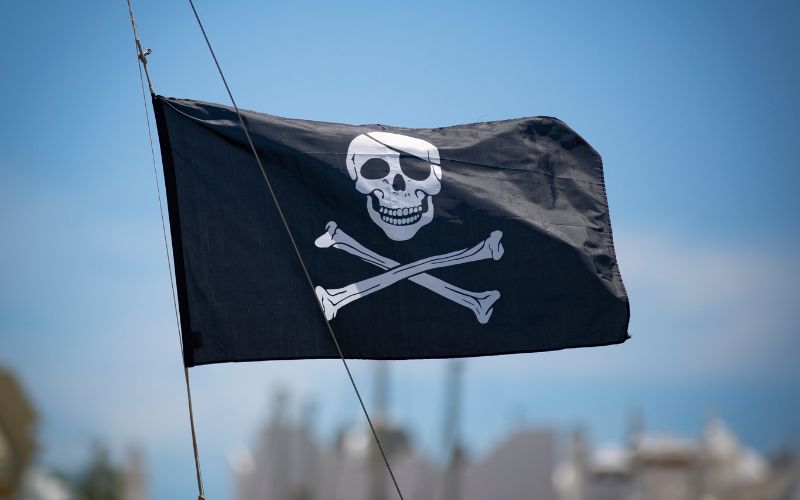
If you want to add adventure and intrigue to your boating experience, consider flying a pirate flag on your boat. Pirate flags, also known as Jolly Roger flags, have long been associated with the swashbuckling world of pirates and have become iconic symbols of adventure on the high seas.
These flags typically feature a skull and crossbones design, meant to strike fear into the hearts of fellow sailors. You can choose from various pirate flag designs, from traditional black and white skulls and crossbones to more colorful and elaborate versions.
History Behind Pirate Flags Flying for Boats
Pirate flags, or Jolly Rogers, emerged during the Golden Age of Piracy in the 17th and 18th centuries. These flags, featuring iconic symbols of pirate lore, were raised to announce the pirates’ arrival and intimidate their victims.
Notable figures like Edward Teach, known as Blackbeard, and Calico Jack Rackham had particularly striking flags. Blackbeard’s displayed a horned skeleton with an hourglass and a stabbed, bleeding heart. Rackham’s flag showed crossed swords under a skull, highlighting his daring nature.
Pirate flags often bore skulls, crossbones, and swords as grave warnings of their intents to loot. A red flag promised a fierce fight, and a black one signified no mercy was forthcoming.
Today, these flags are popular symbols of rebellion and adventure. Their intriguing designs feature in films, literature, and even Halloween costumes, reflecting our enduring fascination with the pirate world.
5. Nautical Flags
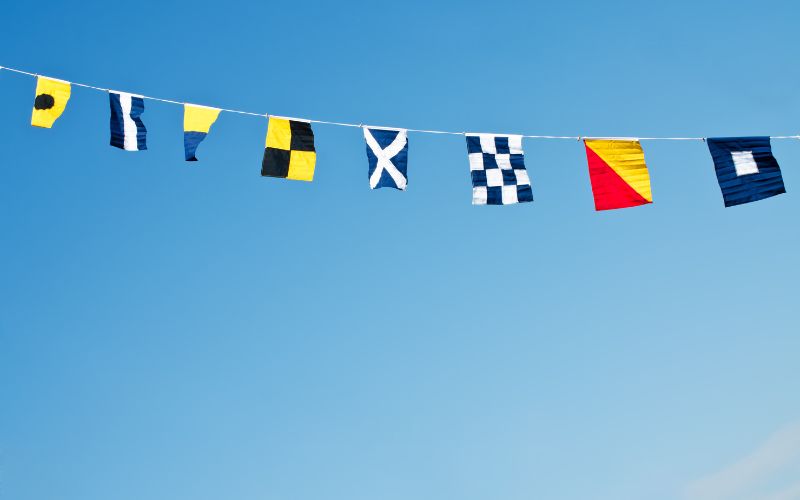
Nautical flags are an essential part of maritime tradition and communication. These brightly colored flags, often flown from boats, yachts, and ships, carry important messages that can be understood by sailors and vessels from afar.
Each flag represents a specific meaning or message, allowing for effective communication between ships, yacht clubs, and recreational boaters. Nautical flags can convey important information regarding dangerous cargo, indicate numeral pennants to represent specific numbers, or display the names of ships and yacht clubs.
The Nautical Alphabet
In the bustling world of maritime operations, effective communication is paramount for the safety and efficiency of vessels. One invaluable tool in this realm is the Nautical Alphabet. A set of visual signals that utilize flags and pennants to convey specific scenarios and requests between ships.
Each alphabet letter is assigned a unique flag or pennant, allowing easy identification and interpretation. For example, the letter “A” is represented by a red and white flag, indicating “Alpha.” This letter flag is hoisted to signal that a vessel has a diver down and caution must be exercised.
Other notable letters include “B” for “Bravo,” represented by a blue and white flag, signaling the presence of dangerous cargo; “C” for “Charlie,” indicated by a blue and yellow pennant, signifying that a vessel needs assistance; and “N” for “November,” a red and yellow pennant used to indicate that a ship is carrying dangerous chemicals.
The Nautical Alphabet is a universal language for sailors, enabling swift and accurate information relay during critical situations. By understanding and adhering to these flags and pennants, maritime personnel can enhance safety, prevent accidents, and facilitate smoother operations.
Solo and Combined Flags
Boats can display between 1 and 7 nautical flags at any given time. The International Code of Signals governs the use of these flags, providing a standardized system for communication at sea. Solo flags, when flown individually, possess their unique meanings.
However, the real power of these International Code Signal flags lies in their combination. By hoisting different flags together, they create a specific message or instruction for other boaters to understand. These combinations can convey requests for assistance, navigational maneuvers, or alerts to potential dangers.
For instance, the “A” flag signifies a vessel’s need for assistance altering its course. While the “R” flag indicates the intention to maneuver reversely. By using these flags appropriately, boats can communicate their intentions, thereby reducing the risk of collisions and maintaining a safe navigation environment.
Nautical Flag Origins and History
Nautical flags have a rich history spanning centuries and are essential to maritime communication. Flags for signaling between ships date back to ancient times when various civilizations utilized visual symbols to convey messages across vast distances.
However, it was in the 19th century that a comprehensive system of nautical flags was established. In 1855, the International Code of Signals was introduced, standardizing the use of flags for communication between vessels. This significant development allowed ships from different nations to understand each other’s signals, enhancing safety and efficiency in maritime operations.
Nautical flags have evolved to meet the changing needs of the shipping industry. Initially, the flags were primarily used to convey important messages, such as distress signals or requests for assistance. Today, they serve multiple purposes, including decoration and identification of boats and yacht clubs.
6. Custom Boat flags
These are a popular option, allowing you to create a unique flag for your boat. You can personalize these flags with designs such as college team logos, military flags, or religious and political-themed flags.
Wrapping Up
Boat flags hold significant meaning and practical importance in the world of boating. From indicating the nationality of a vessel to communicating essential messages and signals, these flags play a crucial role in maintaining safety, promoting camaraderie among boaters, and respecting maritime traditions.
The vast array of boat flag designs and their unique symbolism makes for an exciting and visually appealing aspect of the boating experience. Moreover, not only professionals and seasoned sailors are limited to boat flags. It is an inclusive practice that welcomes and educates novices, fostering a sense of community on the water.
So, whether you’re a seasoned sailor or a recreational boater, getting a flag for your boat can help enhance your boating experience, showcase your identity, and contribute to the rich history and traditions of the maritime world.
- Van Isle Marina
Boat Collisions: How to Avoid Collisions with Another Boat
Boating can be a fun and relaxing activity that many individuals enjoy. Whether cruising along the coastline, fishing with friends,
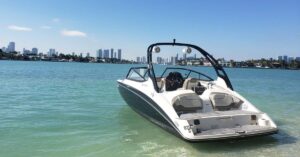
What is a Jet Boat? Propulsion System, Types, Pros and Cons
Jet boats are thrilling, high-speed watercraft making waves in the boating industry. Unlike conventional boats, a jet boat uses powerful
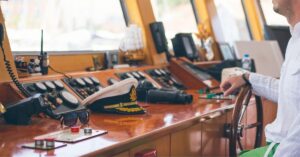
How to Steer a Boat: Mastering the Art of Boat Steering
If you’re ready to embark on a boating adventure and take hold of the helm, it’s time to dive into
Workshop Insider Newsletter
Be a workshop insider get our latest collection of news and announcements delivered to your inbox..., latest articles.
- September 12, 2023
The Ultimate Guide to Pipeliner Welding Hoods: Features, Benefits, Buying Guide, and Best Practices
- Welding Helmets Buying Guides
- September 11, 2023
- September 10, 2023
J-B Weld Removal: How to Remove JB Weld from Metal, Plastic, Skin, and More!
- Mechanical Engineering , Welding Technology
- August 19, 2023
- August 17, 2023
What are Bellows on a Boat: Everything You Need to Know
- August 16, 2023

- Privacy Policy
- Terms of Use
- Affiliate Disclosure

Racing Signals: Sailing Flag Meanings

Last Updated by
Gabriel Hannon
August 30, 2022
Where other competitions have umpires and referees right next to the players, sailing race committees have to rely on flags to communicate with sailors.
In this article, we are going to explain the meanings of all the flags used at regattas to communicate with sailors. The flags can give information about starting procedures, course information, and on-the-water judging, so a basic understanding is a crucial part of general seamanship.
While nautical flags all have defined meanings in a historical context, they have very specific meanings in the context of racing competition. For instance, in the general nautical world, the Z-flag means that you are in distress and are in need of a tow or relief from a tug boat. At a regatta, the race committee may fly the Z-flag to indicate an additional penalty for any boat that has crossed the line early. Moreover, even though there are certain flags that have well-defined roles, race committees may stipulate additional meanings or introduce new flags via an announcement in the sailing instructions for the event, so we will cover some of these more common changes as well. We will break down the meanings into the various categories of usage.
A secret that I have learned over many years of regattas at every level from proverbial ‘beer-can’ races to national championships is that, as well as both you and the race committee can recite the racing flag rules on land, someone is always going to make a mistake or misunderstand these symbols. That is why I will be going through the official flag meanings and rules from the Racing Rules of Sailing for 2021-2024 to clarify any questions that you might have when the race committee flies a flag that hasn’t been seen since we used Clipper Ships to cross the oceans. Hopefully this article will help break down all the most common signals so that when your friend turns to you and asks ‘is that the flag that tells us it's time to go in,’ you’ll be able to help out!
Table of contents
Flags at the Start
The start of a race is often the most confusing part of a regatta and is where the most flags must be used. We will be going over the rules for the flags at a basic 5-minute start. These can be modified for 3-minute dinghy starts, 5-minute match race starts, 6-minute Olympic starts, or 10-minute big boat starts, but the same logic applies.
A few flags are crucial to set everything up on the starting line prior to the starting sequence.

To begin, the race committee must have an Orange Flag visibly displayed, as this demarks the exact location on the boat from which the line is called. If there is a pin boat, they will often fly an Orange Flag as well, but if it is just a buoy, then the buoy serves as the other end of the line.

Next, the RC will additionally fly the L Flag if they are ready for competitors to check-in at the beginning of the race day. This helps them confirm that everyone is sailing under the correct sail number, which is often a logistical nightmare. They will blow one horn when raising this flag. If this flag is raised at any point later in the day, it is meant to tell competitors to come by the committee boat again.

Finally, the AP Flag is a general purpose postponement flag. The race committee may raise this on land to indicate that the harbor start has been delayed or on the water to indicate that there will be a delay in the starts. While there are other flags that are used for abandonment situations, particularly the N Flag, the AP is commonly used in informal situations. Two sounds accompany the raising of the AP, and it can be said that competitors are ‘under AP’ until it is dropped, along with one sound. If it is dropped on land, competitors may immediately launch. If it is dropped on the water, the next start may begin in as little as one minute.

The final note with the AP Flag is that the race committee may indicate the end of racing for the day by flying ‘AP over A.’ Again, the AP could technically be replaced with the blue and white checkerboarded N Flag, but the two serve very similar purposes at most levels.
Starting Flags

Once the race committee is set up and everyone is ready to go sailing, the next task is to get the right fleets to the starting line for their start. At the warning signal, one loud horn that indicates that the 5-minute countdown to the start has begun, the race committee will raise some type of Class Flag that indicates which type of boat will be starting. Above we have the different class flags for the different competition rigs for the ILCA-Dinghy, formerly known as the Laser, which would be raised to indicate which rig is starting.

This is a convention even if there is only one class on the water. Sometimes this is replaced with raising the Orange Flag itself, or some other flag as laid out in the sailing instructions. Often classes have been assigned a numeral pennant, of which 1-4 are displayed above, in place of the highly specific Class Flags. Still, some flag of this nature goes up at 5-minutes and remains up until go, at which point it is dropped.

At 4-minutes, the RC will sound another horn, known as the preparatory signal, and raise some combination of the above flags.
The P Flag is always required to go up, and it is simply the ‘Prep Flag,’ which signals to the racers that they need to get serious about the race. Once the P Flag is raised, all the right-of-way rules that apply during the start switch on and racers, particularly in team and match racing, are allowed to begin tactically engaging with each other (though in team racing this would happen at minute 2 of the 3-minute start). Moreover, racers can talk with their coaches until the prep signal, and race committees may alter the course up until this moment. Afterwards, all coaching is banned and all course changes on the current leg are not allowed. This belies the fact that a 5-minute starting sequence is actually a 4-minute sequence with a warning signal at 5-minutes, but that is a purely semantic detail.
Depending on how rowdy the competitors are, the race committee may raise any combination of the I, Z, U, or Black Flags. Each of these flags deals with boats that start ‘on-course side’ (OCS), essentially a false start for sailing. If any of these flags is raised, a boat is not allowed to be anywhere within the triangle formed by the starting line and the first mark of the course after the 1-minute signal during the start. These flags essentially help the RC ensure that they can get off a clean start and ensure that they can identify any boats that are OCS at go. When they are flown, the following penalties are added beyond requiring a boat to clear itself by dipping back under the line:
- I Flag: Conventionally referred to as the ‘one-minute rule,’ this requires that any boat over the line after a minute also has to sail around an end of the line in order to start the race fairly. This punishes a boat for being over by potentially making it a little harder to clear themselves if they are over on a large line.
- Z Flag: Often flown in combination with the I Flag, this flag adds that any boat that is OCS will get a 20% penalty on top of their score in that race, regardless of whether they clear themselves or not. This further hurts any boat that is ‘pushing the line’ by ensuring that even if they manage to clear themselves and come back, they will still see an impact on their scoreline that is equivalent to immediately being passed by 20% of the fleet.
- U Flag: Now we’re getting into harsh territory. When the RC is really trying to brush the fleet back off the plate, this flag immediately disqualifies a boat that is over after a minute with no course for redress. If these boats are identified, they tend to be told to stop sailing the race by a notice board at the top mark.
- Black Flag: The black flag serves a very similar purpose to the U Flag, except it is a step harsher. It disqualifies you after a minute and even prevents you from sailing in a restart of the race or a race abandoned halfway through.
The I Flag is by far the most common flag, and is often effective at keeping boats from being over. The U Flag rule was introduced in 2013 as an option and formally codified in the Racing Rules in 2017 and is massively more popular than the Black Flag, which is considered overly punitive. In particular, when many sailors are over in a Black Flag start, such that the RC cannot determine who was over, they are forced to make unfair decisions that carry over to the restart, so the U is now almost universally used in its place. Additionally, as the U has become more popular, people tend to shy away from the Z flag, which is considered cumbersome for scorers and confusing to sailors.
In general, while these flags are supposed to be raised in conjunction with the P Flag, often the RC will only raise the most punitive of the flags, as any of them can essentially be considered as a prep flag.
As the starting sequence continues, any prep flag(s) raised must be lowered at the 1-minute signal. The class flag is then lowered at go, leading to the next category of flags: Recall Flags
Recall Flags
After the pain of raising and lowering all those start flags, the RC then has three possible jobs. If the start is clean, they shout ‘All Clear!’ and can then relax until they have to start another race or record finishes for the race in progress. Unfortunately, this is often not the case, as they likely will need to ‘recall’ certain competitors for being ‘OCS,’ i.e. false starting. They have two choices here.

If only a few, easily-identifiable boats have started early, the RC will raise the X Flag along with a single sound in what is referred to as an individual recall. This indicates to the boats on the course that there are some competitors who are currently OCS and must clear themselves. If the I Flag had been flown for the start, competitors have to round an end; if not, they can just dip back behind the starting line and restart from there.
While the X is suitable on its own to inform a boat that it has been called over, it is an oft practiced courtesy for the RC to hail an OCS boat’s sail number over a megaphone, a radio, or other transmission device. The X Flag is dropped when all OCS boats have cleared themselves or after 4 minutes from go, whichever comes first.

If more boats than can be easily identified are called over, the RC can blow two horns and fly the First Substitute Flag, indicating a general recall. In this case, the race is fully reset and the committee will initiate another entire starting sequence for that fleet. After a general recall, the RC will often, but not always employ the next level of penalty flag for the restart in an attempt to get the race off cleanly.
Sometimes, as in college sailing or as stipulated by other sailing instructions, any general recall immediately implies the I Flag for the next sequence if it had not been flown previously. As such, the RC does not necessarily have to fly the I if it is unavailable. Still, such stipulations are almost always written out explicitly for a given event and are often accompanied by a verbal announcement as a courtesy.
Still, outside some usages of the AP or N Flags to abandon or delay starts already in sequence, these are all the flags that deal with general housekeeping and the starting sequence.
While Underway
While the starting flags are by far the most complicated of the flag rules, there are still other flags to keep track of while racing. The first among these are...
Course Change Flags
Although course changes are relatively rare, race committees often pull them out when conditions change substantially during races or if there has been a problem with one of the marks.

When wind or time constraints require, the race committee may send an official to any mark of the course that no boat has yet rounded and have it raise the S Flag along with two sounds. This indicates that the fleet shall finish at that mark, cutting off the race earlier than written in the sailing instructions.

In the case of any other change to the course, such as a minor adjustment to the angle or distance of an upcoming leg, a race committee boat will go to the preceding mark and raise the C Flag along with repeated sounds.
This is sometimes accompanied by a Red Square or a Green Triangle to indicate that the mark has been moved to port or starboard respectively. Although during less formal events, you can change the positions of any marks so long as there are no competitors currently sailing on that leg of the course, it is considered poor form if at all possible to inform competitors, particularly in longer races. Sailors make decisions based on the position of the marks, and if this has been changed without them noticing, that can drastically affect the outcomes of strategic decisions, so in large competitions the C Flag is a must.

If, meanwhile, something odd has happened to a mark of the course, any official boat may fly the M Flag with repeated signals. This serves to inform the competitors that they have become a replacement for the missing mark. This is relatively uncommon, but anchors do occasionally snap on marks, so it is always good to have a support boat with the M if possible.

Finally, as mentioned before, if conditions have deteriorated to the point that a race is considered no longer possible, due to lack of wind, fear of foul weather, or some form of interference -- I’ve seen it happen because cruise ships wanted to pass through a dinghy course, and you don’t say no to them -- the race committee may abandon the race using the N Flag. Still, this flag is relatively rare as you will often see the AP in its place for convenience, as they are functionally similar.
Miscellaneous Flags
While we have covered the bulk of the flags necessary for racing at any level, there are a few more flags from across different disciplines and classes that are worth mentioning, if only to let you in on these quirky parts of the racing world! This starts with what one could reasonably call…
The Cheating Flag

Calling the O Flag the cheating flag is certainly a bit of a misnomer. The O Flag does, however, suspend Rule 42 of the Racing Rules of Sailing. Rule 42 is particularly notorious, as it bans pumping, rocking, ooching, sculling, and excessive maneuvering, all of which are methods to make your boat go substantially faster. While Rule 42 is worth an article in and of itself, the larger point is that it is meant to keep anyone from gaining an unfair advantage over their competitors.
Certain competitive classes, however, including the Olympic class 470s and Finns and many of the new foiling fleets, allow competitors to ignore Rule 42 in certain conditions, typically in heavy breezes that are referred to as ‘planing’ conditions. There are differences across the classes, but whenever it is allowed and the RC flies the O Flag, Rule 42 is switched off and competitors can ooch, pump, rock, and tack their boats all around the racecourse. This allows for a much more physical style of sailing and is a rule that many different classes and sectors of sailing are beginning to consider.

If conditions no longer meet the threshold for that class’s rules regarding suspension of Rule 42, an official boat will raise the R Flag at some point during the race. They can only do so at a mark of the course so that it is fair to all the competitors throughout the fleet. This is relatively rare, and is normally done between races, but is still a key part of the O Flag rule.
Judge and Umpire Flags
On the topic of Rule 42, there are certain fouls in sailing that can be actively enforced on the water by judges or umpires, depending on the context.
Rule 42 is enforced by judges with a Yellow Flag, which they will point at an offending boat along with a sound signal and a direct sail number hail. That boat may clear themselves from their first Yellow Flag by taking their two-turn penalty, but, unless otherwise noted in the sailing instructions, any subsequent violation can entail disqualification.
Finally, certain levels of modern match and team racing, with the addition of high-performance racing like SailGP, have full on-the-water umpires who actively follow the racing to make calls on fouls and other plays. While this is not the spot to go through the intricacies of team and match race calls, the basic gist is as follows.
In any interaction, any boat involved in the race may call in the umpires if they believe that their opponent has fouled them. If the opponent clears themselves quickly, essentially admitting fault, the umpires will not get involved. If no boats clear themselves, the umpire has to make a call on whether there has been a foul. If they determine that the maneuvers were clean, they will make one sound and fly a Green Flag, thus exonerating all boats in the interaction. If they determine there was a foul, they will fly a Red Flag with a singular sound and hail the offending boat.
Beyond that, if a boat is found to have broken a rule not related to an interaction, the umpires may come in and fly the Red Flag without being directly invited into the situation. Further, if a boat is found to be in violation of sportsmanship or refuses to take a penalty as assessed by an umpire, the umpire may fly a Black Flag, disqualifying them from the race.
While there are differences at each event and in each discipline, these general guidelines are followed in most umpired races, with specific flags used at various events, generally depending on availability.
With that, we have made it from land, through the start, a few general recalls, all the way to umpire flags! I hope this has helped you get a grasp of the various flags used across sailing. While this has not scratched the specifics of the various alterations made for kiteboards and windsurfers, nor some of the annoyances of protest flags and more, we have gone through the bulk of regularly used race committee and umpire signals.
The ‘Wear Your Life Jacket!’ Flag

Finally, we have a safety flag. At big boat regattas, the race committee may, if it chooses, fly the Y Flag at any point prior to a start to inform competitors that they must wear personal floatation devices, which is not always strictly necessary.
The Most Important Flag
While I wish I could tell you that everyone uses their flags properly and accompanies them with the proper timing and sound signals, that is far from the truth. Everyone’s flag set is slightly incomplete or out of date, and invariably there is going to be a miscommunication somewhere, where the race committee forgets to put the I Flag up but really should have; I’ve certainly done that a time or two. Still, there’s nothing quite like being on the water, so, despite the endless mutual griping between racers and their race committees, hopefully everyone comes back to shore flying the ‘Happy Flag.’
Happy sailing!
Related Articles
I have been sailing since I was 7 years old. Since then I've been a US sailing certified instructor for over 8 years, raced at every level of one-design and college sailing in fleet, team, and match racing, and love sharing my knowledge of sailing with others!
by this author
Most Recent

What Does "Sailing By The Lee" Mean?
Daniel Wade
October 3, 2023

The Best Sailing Schools And Programs: Reviews & Ratings
September 26, 2023
Important Legal Info
Lifeofsailing.com is a participant in the Amazon Services LLC Associates Program, an affiliate advertising program designed to provide a means for sites to earn advertising fees by advertising and linking to Amazon. This site also participates in other affiliate programs and is compensated for referring traffic and business to these companies.
Similar Posts

How To Choose The Right Sailing Instructor
August 16, 2023

Basics Of Sailboat Racing Explained
May 29, 2023

Cost To Sail Around The World
May 16, 2023
Popular Posts

Best Liveaboard Catamaran Sailboats
December 28, 2023

Can a Novice Sail Around the World?
Elizabeth O'Malley
June 15, 2022

4 Best Electric Outboard Motors

How Long Did It Take The Vikings To Sail To England?

10 Best Sailboat Brands (And Why)
December 20, 2023

7 Best Places To Liveaboard A Sailboat
Get the best sailing content.
Top Rated Posts
Lifeofsailing.com is a participant in the Amazon Services LLC Associates Program, an affiliate advertising program designed to provide a means for sites to earn advertising fees by advertising and linking to Amazon. This site also participates in other affiliate programs and is compensated for referring traffic and business to these companies. (866) 342-SAIL
© 2024 Life of Sailing Email: [email protected] Address: 11816 Inwood Rd #3024 Dallas, TX 75244 Disclaimer Privacy Policy
Fax: (315) 686-2680

- Officers & Directors
- Past ACBS Presidents
- ACBS Judging Classifications
- ACBS Awards and Criteria
- Education & Scholarships
- ACBS Annual Meeting & International Boat Show Schedule
- 2024 Vintage Boat Week – Woods and Water II
- 2023 Vintage Boat Week
- Classifieds
- ACBS Rudder
- Marque Clubs
- Boat Restoration
- Boating Safety
- Send Message to ACBS Staff
- Submit your News & Stories
- Submit An Event For The Calendar
BURGEES, ENSIGNS, FLAGS and PENNANTS

By Judy Hills, ACBS roving reporter, member of RDC Triangle Chapter
Have you ever given thought to the burgees, ensigns, flags and pennants that we fly on our boats? Did you consciously select yours or did you just copy what you saw someone else doing? What do you know about nautical flag etiquette and usage? This article addresses this topic.

According to the US Power Squadron, “Flags are often too small…The national ensign flown at a flag staff on the stern of your boat should be one inch on the fly (long end) for each foot of overall length.”
Flag —One class of flags is called the “international maritime signal flags.” According to Wikipedia, there is a signal flag “for each letter of the alphabet, and pennant for numerals. Each flag (except the R flag) has an additional meaning when flown individually, and they take on other meanings in certain combinations.” For more information on the meanings of international maritime signal flags click on this link: http://www.marinewaypoints.com/learn/flags/flags.shtml It is more common to see the international maritime signal flags displayed on sailboats than pleasure power boats.

Did you know?
- The word for the scientific study of the history, symbolism and usage of flags is vexillology.
- The position of honor on a ship is the quarterdeck at the stern of a ship, and thus ensigns are traditionally flown either from the ensign staff at the ship’s stern, or from a gaff rigged over the stern.
- The general rule that no flag is flown higher than the national flag does not apply onboard a ship. A flag flown at the stern is always in a superior position to a flag flown elsewhere on the ship, even if the latter is higher up. (Wikipedia—maritime flag).
- If you take your boat to international or foreign waters, the traditional United States ensign should be flown.
- You should avoid flying more than one ensign from a single halyard or antenna.
- Massachusetts and Maine are the only two states with their own maritime flags (special versions of the state flags for use afloat).
- There is an international burgee registry. http://www.burgees.com/burgeeframe.htm
- To learn more about maritime flag etiquette: http://www.usps.org/f_stuff/etiquett.html
- If you are into vexillology and want to see some really weird flag designs, check out https://www.reddit.com/r/vexillology/ or click here to see vexillology Youtube videos. Click here to check out the National Maritime Museum’s historical collection of flags.
So, having a little fun with our vexillology topic, if you or your ACBS Chapter were to design a flag, what would it look like?
Send your pictures, reports, announcements, and boat biographies to [email protected]
Nice informative piece, thx. One concern: I recently ordered and attempted to fly the ACBS burgee on my ’55 Chris-Craft Continental 22′ and discoverd that the height measurement (~13″) is way too long for my canted mast (pins are about 9″ apart). Has ACBS considered a more “runabout” size for a burgee?
I contacted the company that we purchase the burgees from. The company offers a 10″ size which should place the grommet holes about 9″ apart. If you would like me to order one for you, let me know if you prefer cotton or nylon and slanted or straight. The cost is $39.
This added information came from Gene Porter: “Your yacht ensign info is inaccurate or remiss in that it fails to note that the yacht ensign must never be flown in international or foreign waters since it has no standing as a national ensign. [from the Power Squadron web site]
This is particularly applicable in such areas as the Thousand Islands where US boats frequent Canadian waters, too often flying illegal flags.
Thank you, Gene. One of the advantages of being in this organization is that information is shared from many sources. The website committee invites comments and discussions. It helps us all be more informed.
I fly the flag and ensign that was actually shipped from Century in June of 1959 when my Gray V8 powered 16 ‘ Resorter was delivered to Ithaca NY, she has only had two owners and moved 15 miles North still on Cayuga l and is now used mostly for sunset rides, she saw many hours as a competition ski boat as her original owner was a skier for many years she has also made the trip from Sodus Bay NY across Lake Ontario to the St. Lawrence seaway twice a year for many years to his cottage on the St Lawrence.
Great article but I believe you left out an important fact about the U S ensign. Congress in 1914 or 1916, please don’t hold me to the dates, pasted a law that made the United States Power Squadrons flag an official flag for U S yachts. Bob Korts Member USPS since 1960.
Did you know original ensign flags had sewn stars not embroidered stars like we see today. The stars were cut out of fabric and sewn around the edges.
Leave a Reply Cancel reply
Your email address will not be published. Required fields are marked *
Save my name, email, and website in this browser for the next time I comment.
Post comment
This site uses Akismet to reduce spam. Learn how your comment data is processed .
Buckeye Lake Yacht Club
Founded 1906

What Do All those Flags Mean?
Commodore Steve Harris – October, 2014
This month’s “history” article isn’t so much historical as it is perhaps educational. Recently, several people have asked me about the flags that we fly on the yardarm in front of the Clubhouse. While flying such flags at a yacht club is a tradition, how is one to learn what they mean and why they’re flown?
At the top of the yardarm on the “mast” flies our BLYC burgee. This identifies our “ship,” our club. Burgees are also flown on boats to identify the owner as a member of the club as well.
On sailing ships, officer flags are flown to indicate who the ranking officers are that are on board at the current time or which officer in the fleet is in command on that ship. On the right halyard of our yardarm as you look from the porch towards the lake, we fly officer flags for the three “flag officers” of the Club – Commodore (white on blue), Vice Commodore (white on red), and Rear Commodore (red on white) – and one for our Past Commodores (3 stars and a fouled anchor; white on blue). At some clubs these are flown only when those officers are present. At BLYC, we usually fly them all the time to show respect for those officers.
On the left side of the yard arm as you will find flags indicating our Club’s affiliations with other organizations. In the top-most spot on that side, we fly the burgee of the Inter-Lake Yachting Association, our regional sailing & boating organization in this area. Below that, we fly a pennant bearing the logo of US Sailing – the national governing body for the sport of sailing – of which we are also a member. Finally, we fly the burgee of the International Order of the Blue Gavel, an association of Past Commodores of Yacht Clubs.
Often, Clubs will also have a “courtesy” spot on their yardarm from which they may fly the burgee of another club when someone from that Club is visiting.
If one looks around the Clubhouse, there are plenty of other flags and Yacht Club traditions that probably could stand to be explained too. I’ll have to look around for topic ideas for future articles…
Enjoying our Buckeye Lake History Articles?
Please feel free to share on social media with proper attribution to Buckeye Lake Yacht Club and a link to this page.

IMAGES
VIDEO
COMMENTS
4. Solo or combined, nautical flags convey meaning. Depending on the intended message, boats fly one flag or up to seven flags in a row. For example, if you see the A (Alpha) flag, this means "diver down, keep clear.". If you see the W (Whiskey) flag, the boat has a medical emergency and needs help.
Nautical flags, also known as maritime signal flags, are a set of flags and pennants used to communicate messages between ships and boats. Each flag represents a specific letter, number, or message, allowing vessels to convey information even when verbal communication is not possible. The use of nautical flags dates back centuries and continues ...
1. Pay attention to the flag's shape. Most nautical flags are squares. Additionally, you'll find some resembling triangles but with flat tips—a.k.a. pendants. These two shapes are the most common. 2. Learn the nautical flag alphabet. Conveniently, for every letter of the alphabet, there's an equivalent square nautical flag.
One or more flags form a code word whose meaning can be looked up in a code book held by both parties. An example is the Popham numeric code used at the Battle of Trafalgar . In yacht racing and dinghy racing , flags have other meanings; for example, the P flag is used as the "preparatory" flag to indicate an imminent start, and the S flag ...
For example, yacht clubs often use burgee flags to identify themselves, and boats may fly a particular flag to indicate their nationality or affiliation. Nautical flags come in different shapes, sizes, and colors, each with a specific meaning. Nautical Flag Uses and Meanings. Communication - Nautical flags are used to communicate between ...
International Nautical Flag Meanings. Each flag representing a letter of the alphabet has a meaning. The meanings are as follows: A or Alpha - keep clear, diver down. B or Bravo - carrying dangerous cargo. C or Charlie - yes. D or Delta - keep clear. E or Echo - altering course to starboard. F or Foxtrot - I am disabled.
Combining Oscar and Whiskey flags, indicates "Man overboard. I require medical assistance". 2 nautical flags together usually indicate a problem or hazard, requesting either assistance or a wide birth. Three or more flags can signal compass points, location coordinates, names and often include pennants. Mast of an ancient sailing vessel.
Nautical flags are part of an international code signaling system. These flags represent letters of the alphabet, numbers, and other signals, and they come in vibrant colors like red, blue, yellow, black, and white for maximum visibility. The combinations of these colors were carefully chosen to be easily distinguishable from afar.
Yacht flags, in particular, are used to signal the boat's identity, status, or intention. For example, a yellow and blue flag with a white anchor in the center is a signal for a vessel that is at anchor. A white flag with a blue square and a white cross in the center signals that the boat is a medical vessel or has a medical emergency on board.
Nautical flags can have many meanings: Complex messages. Warnings. Secret coded messages. Military communication. Indications for speed and direction. Race start signals and shortened courses. As an experienced boater, it's important to be familiar with the common meanings for many popularly used nautical flags.
Nautical Flags and Their Meanings. The purpose of the International Code of Signals is to provide ways and means of communication in situations related essentially to safety of navigation and persons, especially when language difficulties arise, or because radio silence is required. Here are their names and meanings, both International and/or ...
The Nautical Flag Alphabet. The international code of signals for the letters of the alphabet are as follow: A: Alpha - diver down; keep clear. B: Bravo - carrying dangerous cargo. C: Charlie - yes (affirmative) D: Delta - keep clear of me, I am maneuvering with difficulty. E: Echo - altering course to starboard.
Nautical Flags and Their Meanings - Royal Melbourne Yacht Squadron
Signal flags signal your status, warning or need to a ship without a chance of misinterpretation. People use nautical flags to express a status, warning or a need. Each flag does have it's own letter but it is rarely used for spelling. Every flag has it's unique meaning and those signals are ones most common out at sea.
For power boats, all other flags should be 5/8″ long for each foot of overall length. A 56-foot boat should have a 35-inch long flag. Proper boat flag size varies depending on the size of the boat in question. Semaphore flags (discussed below) are always made as an 18″ x 18″ square.
Other nautical flags include the national ensign, yacht club burgee, sailing regatta flags and hurricane warning flags that indicate the area is expecting winds of 74 mph or higher. Photo: Pixabay. As a recreational boater, you may never need to use the majority of these marine flags as you come and go from your private boat slip rental.
Nautical flags, flown solo or in combination, convey diverse meanings. Each flag encapsulates a specific message, fostering effective communication at sea. A single flag might indicate a vital message. For instance, the Alpha "A" flag signals a diver's presence underwater, warning nearby vessels to steer clear.
Each flag represents a specific meaning or message, allowing for effective communication between ships, yacht clubs, and recreational boaters. Nautical flags can convey important information regarding dangerous cargo, indicate numeral pennants to represent specific numbers, or display the names of ships and yacht clubs.
Nautical flags, or signal flags, are an internationally understood method for vessel communication. Depending on the context, each flag has a specific meaning. With language and cultural differences, this form of communication is unambiguous and effective. Most often the flag meaning rather than its letter is the key message as spelled-out ...
Boat Steering Systems. Dive into the sea of maritime communication with our Ultimate Guide to Nautical Flags. Decode meanings, understand signals and navigate the waves confidently.
The flags can give information about starting procedures, course information, and on-the-water judging, so a basic understanding is a crucial part of general seamanship. While nautical flags all have defined meanings in a historical context, they have very specific meanings in the context of racing competition. For instance, in the general ...
Flag—One class of flags is called the "international maritime signal flags." According to Wikipedia, there is a signal flag "for each letter of the alphabet, and pennant for numerals. Each flag (except the R flag) has an additional meaning when flown individually, and they take on other meanings in certain combinations."
In the days of the old sailing ships, signal flags were hoisted on halyards (lines) off these yards, or yardarms, to communicate with other vessels. Our yardarm at BLYC, like those found at yacht clubs all over the world, serves a similar purpose. At the top of the yardarm on the "mast" flies our BLYC burgee. This identifies our "ship ...